Похожие презентации:
Injury of genitourinary organs
1. INJURY OF GENITOURINARY ORGANS
2. Emergency Diagnosis & Management
Emergency Diagnosis & ManagementAbout 10% of all injuries seen in
the emergency room involve the
genitourinary system to some
extent.
3. Emergency Diagnosis & Management
Emergency Diagnosis & ManagementMany of them are subtle and
difficult to define and require
great diagnostic expertise.
Early diagnosis is essential to
prevent serious complications.
4. Emergency Diagnosis & Management
Emergency Diagnosis & ManagementInitial assessment should include control of
hemorrhage and shock along with
resuscitation as required.
5. Emergency Diagnosis & Management
Emergency Diagnosis & ManagementThe history should include a detailed
description of the accident. In cases
involving gunshot wounds, the type and
caliber of the weapon should be
determined, since high-velocity
projectiles cause much more extensive
damage.
6. Emergency Diagnosis & Management
Emergency Diagnosis & ManagementThe abdomen and genitalia should be
examined for evidence of contusions or
subcutaneous hematomas, which might
indicate deeper injuries to the
retroperitoneum and pelvic structures.
7. Emergency Diagnosis & Management
Emergency Diagnosis & ManagementFractures of the lower ribs are often
associated with renal injuries, and pelvic
fractures often accompany bladder and
urethral injuries.
8. Emergency Diagnosis & Management
Emergency Diagnosis & ManagementPatients who do not have life-threatening
injuries and whose blood pressure is
stable can undergo more deliberate
radiographic studies.
9. Emergency Diagnosis & Management
Emergency Diagnosis & ManagementWhen genitourinary tract injury is
suspected on the basis of the history
and physical examination, additional
studies are required to establish its
extent.
10. Assessment of Injury
Assessment of the injury should be done inan orderly fashion so that accurate and
complete information is obtained.
11. Catheterization
Blood at the urethral meatus in menindicates urethral injury; catheterization
should not be attempted if blood is
present, but retrograde urethrography
should be done immediately.
12. Catheterization
If no blood is present at the meatus, aurethral catheter can be carefully passed
to the bladder to recover urine;
microscopic or gross hematuria indicates
urinary system injury.
13. Catheterization
If catheterization is traumatic despite thegreatest care, the significance of
hematuria cannot be determined, and
other studies must be done to investigate
the possibility of urinary system injury.
14. Computed Tomography (CT)
Abdominal CT with contrast media is thebest imaging study to detect and stage
renal and retroperitoneal injuries.
15. Computed Tomography (CT)
It can define- the size
- extent of the retroperitoneal hematoma
16. Computed Tomography (CT)
Spiral CT scanning, now common, is veryrapid, but it may not detect renal
parenchymal lacerations, urinary
extravasation, or ureteral and renal pelvic
injuries.
17. Retrograde Cystography
Filling of the bladder with contrast materialis essential to establish whether bladder
perforations exist.
18. Retrograde Cystography
A film should be obtained with the bladderfilled and a second one after the bladder
has emptied itself by gravity drainage.
19. Retrograde Cystography
Cystography with CT is excellent forestablishing bladder injury.
20. Urethrography
A small (12F) catheter can be inserted intothe urethral meatus and 3 mL of water
placed in the balloon to hold the catheter
in position.
21. Urethrography
After retrograde injection of 20 mL of watersoluble contrast material, the urethra will beclearly outlined on film, and extravasation in
the deep bulbar area in case of straddle injury
or free extravasation into the retropubic space
in case of prostatomembranous disruption will
be visualized.
22. Arteriography
Arteriography may help define renalparenchymal and renal vascular injuries.
23. Intravenous Urography
Intravenous urography can be used todetect renal and ureteral injury.
24. Cystoscopy and Retrograde Urography
Cystoscopy and retrograde urography maybe useful to detect ureteral injury, but are
seldom necessary, since information can
be obtained by less invasive techniques.
25. Abdominal Sonography
Abdominal sonography has not been shownto add substantial information during
initial evaluation of severe abdominal
trauma.
26. Injuries to the Kidney
Renal injuries are the most commoninjuries of the urinary system.
27. Injuries to the Kidney
Most injuries occur from automobileaccidents or sporting mishaps, chiefly in
men and boys..
28. Injuries to the Kidney
EtiologyBlunt trauma directly to the abdomen,
flank, or back is the most common
mechanism, accounting for 80-85% of all
renal injuries.
29. Injuries to the Kidney
Vehicle collisions at high speed may resultin major renal trauma from rapid
deceleration and cause major vascular
injury.
30. Injuries to the Kidney
Associated abdominal visceral injuries arepresent in 80% of renal penetrating
wounds.
31. Pathology & Classification Early Pathologic Findings
Pathology & ClassificationEarly Pathologic Findings
Lacerations from blunt trauma usually
occur in the transverse plane of the
kidney.
32. Pathology & Classification Early Pathologic Findings
Pathology & ClassificationEarly Pathologic Findings
In injuries from rapid deceleration, the
kidney moves upward or downward,
causing sudden stretch on the renal
pedicle and sometimes complete or
partial avulsion.
33. Pathology & Classification Early Pathologic Findings
Pathology & ClassificationEarly Pathologic Findings
Acute thrombosis of the renal artery
may be caused by an intimal tear
from rapid deceleration injuries
owing to the sudden stretch.
34. Pathology & Classification Hydronephrosis
Pathology & ClassificationHydronephrosis
Follow-up excretory urography is indicated
in all cases of major renal trauma.
35. Pathology & Classification Arteriovenous Fistula
Pathology & ClassificationArteriovenous Fistula
Arteriovenous fistulas may occur after
penetrating injuries but are not
common
36. Pathology & Classification Renal Vascular Hypertension
Pathology & ClassificationRenal Vascular Hypertension
The blood flow in tissue rendered
nonviable by injury is compromised; this
results in renal vascular hypertension in
less than 1% of cases.
37. Clinical Findings & Indications for Studies
Clinical Findings & Indications for StudiesMicroscopic or gross hematuria following
trauma to the abdomen indicates injury to
the urinary tract.
38. Clinical Findings & Indications for Studies
Clinical Findings & Indications for StudiesSome cases of renal vascular injury are not
associated with hematuria.
39. Clinical Findings & Indications for Studies
Clinical Findings & Indications for StudiesThe degree of renal injury does not correspond to
the degree of hematuria, since gross hematuria
may occur in minor renal trauma and only mild
hematuria in major trauma
40. Clinical Findings & Indications for Studies
Clinical Findings & Indications for StudiesMiller and McAninch (1995) made the following
recommendations based on findings in over
1800 blunt renal trauma injuries.
41. Clinical Findings & Indications for Studies
Clinical Findings & Indications for StudiesHowever, should physical examination or
associated injuries prompt reasonable
suspicion of a renal injury, renal imaging
should be undertaken.
42. Clinical Findings & Indications for Studies
Clinical Findings & Indications for StudiesSymptoms
There is usually visible evidence of abdominal
trauma. Pain may be localized to one flank
area or over the abdomen.
43. Clinical Findings & Indications for Studies
Clinical Findings & Indications for StudiesCatheterization usually reveals hematuria.
44. Clinical Findings & Indications for Studies Signs
Clinical Findings & Indications for StudiesSigns
Initially, shock or signs of a large loss of
blood from heavy retroperitoneal
bleeding may be noted.
45. Clinical Findings & Indications for Studies Signs
Clinical Findings & Indications for StudiesSigns
Diffuse abdominal tenderness may be found on
palpation; an "acute abdomen" usually
indicates free blood in the peritoneal cavity. A
palpable mass may represent a large
retroperitoneal hematoma or perhaps urinary
extravasation.
46. Clinical Findings & Indications for Studies Signs
Clinical Findings & Indications for StudiesSigns
The abdomen may be distended and bowel
sounds absent.
47. Clinical Findings & Indications for Studies Laboratory Findings
Clinical Findings & Indications for StudiesLaboratory Findings
Microscopic or gross hematuria is usually
present.
48. Clinical Findings & Indications for Studies Staging and X-Ray Findings
Clinical Findings & Indications for StudiesStaging and X-Ray Findings
Staging of renal injuries allows a
systematic approach to these problems.
49. Clinical Findings & Indications for Studies Staging and X-Ray Findings
Clinical Findings & Indications for StudiesStaging and X-Ray Findings
For example, blunt trauma to the abdomen
associated with gross hematuria and a normal
urogram requires no additional renal studies;
however, nonvisualization of the kidney
requires immediate arteriography or CT scan
to determine whether renal vascular injury
exists.
50. Clinical Findings & Indications for Studies Staging and X-Ray Findings
Clinical Findings & Indications for StudiesStaging and X-Ray Findings
Ultrasonography and retrograde urography
are of little use initially in the evaluation
of renal injuries.
51. Clinical Findings & Indications for Studies Staging and X-Ray Findings
Clinical Findings & Indications for StudiesStaging and X-Ray Findings
Staging begins with an abdominal CT scan,
the most direct and effective means of
staging renal injuries.
52. Clinical Findings & Indications for Studies Staging and X-Ray Findings
Clinical Findings & Indications for StudiesStaging and X-Ray Findings
This noninvasive technique clearly
- defines parenchymal lacerations and urinary
extravasation,
53. Clinical Findings & Indications for Studies Staging and X-Ray Findings
Clinical Findings & Indications for StudiesStaging and X-Ray Findings
Arteriography defines major arterial and
parenchymal injuries when previous studies
have not fully done so.
54. Clinical Findings & Indications for Studies Staging and X-Ray Findings
Clinical Findings & Indications for StudiesStaging and X-Ray Findings
The major causes of nonvisualization on an
excretory urogram are total pedicle avulsion,
arterial thrombosis, severe contusion causing
vascular spasm, and absence of the kidney
(either congenital or from operation).
55. Clinical Findings & Indications for Studies Staging and X-Ray Findings
Clinical Findings & Indications for StudiesStaging and X-Ray Findings
Radionuclide renal scans have been used in
staging renal trauma.
56. Clinical Findings & Indications for Studies Differential Diagnosis
Clinical Findings & Indications for StudiesDifferential Diagnosis
Trauma to the abdomen and flank areas is
not always associated with renal injury.
57. Clinical Findings & Indications for Studies Complications
Clinical Findings & Indications for StudiesComplications
Early Complications
Hemorrhage is perhaps the most important
immediate complication of renal injury.
58. Clinical Findings & Indications for Studies Complications
Clinical Findings & Indications for StudiesComplications
The size and expansion of palpable masses
must be carefully monitored.
59. Clinical Findings & Indications for Studies Complications
Clinical Findings & Indications for StudiesComplications
Urinary extravasation from renal fracture
may show as an expanding mass (urinoma)
in the retroperitoneum.
60. Clinical Findings & Indications for Studies Complications
Clinical Findings & Indications for StudiesComplications
A resolving retroperitoneal hematoma may
cause slight fever (38.3 °C), but higher
temperatures suggest infection.
61. Clinical Findings & Indications for Studies Complications
Clinical Findings & Indications for StudiesComplications
Late Complications
Hypertension, hydronephrosis, arteriovenous
fistula, calculus formation, and
pyelonephritis are important late
complications.
62. Clinical Findings & Indications for Studies Complications
Clinical Findings & Indications for StudiesComplications
Heavy late bleeding may occur 4 weeks after
injury.
63. Clinical Findings & Indications for Studies Treatment: Emergency Measures
Clinical Findings & Indications for StudiesTreatment: Emergency Measures
The objectives of early management are
prompt treatment of shock and
hemorrhage, complete resuscitation, and
evaluation of associated injuries.
64. Clinical Findings & Indications for Studies Treatment: Surgical Measures
Clinical Findings & Indications for StudiesTreatment: Surgical Measures
Blunt Injuries
Bleeding stops spontaneously with bed rest
and hydration.
65. Clinical Findings & Indications for Studies Treatment: Surgical Measures
Clinical Findings & Indications for StudiesTreatment: Surgical Measures
Cases in which operation is indicated include those
associated with persistent retroperitoneal
bleeding, urinary extravasation, evidence of
nonviable renal parenchyma, and renal pedicle
injuries (less than 5% of all renal injuries).
Aggressive preoperative staging allows complete
definition of injury before operation.
66. Clinical Findings & Indications for Studies Treatment: Surgical Measures
Clinical Findings & Indications for StudiesTreatment: Surgical Measures
Penetrating Injuries
Penetrating injuries should be surgically explored.
67. Clinical Findings & Indications for Studies Treatment: Surgical Measures
Clinical Findings & Indications for StudiesTreatment: Surgical Measures
In 80% of cases of penetrating injury, associated
organ injury requires operation; thus, renal
exploration is only an extension of this
procedure.
68. Clinical Findings & Indications for Studies Treatment: Surgical Measures
Clinical Findings & Indications for StudiesTreatment: Surgical Measures
Treatment of Complications
Hydronephrosis may require surgical
correction or nephrectomy.
69. Clinical Findings & Indications for Studies Treatment: Surgical Measures
Clinical Findings & Indications for StudiesTreatment: Surgical Measures
Prognosis
With careful follow-up, most renal injuries have an
excellent prognosis, with spontaneous healing
and return of renal function.
70. Clinical Findings & Indications for Studies Treatment: Surgical Measures
Clinical Findings & Indications for StudiesTreatment: Surgical Measures
Injuries to the Ureter
Ureteral injury is rare but may occur, usually
during the course of a difficult pelvic surgical
procedure or as a result of gunshot wounds.
71. Clinical Findings & Indications for Studies Treatment: Surgical Measures
Clinical Findings & Indications for StudiesTreatment: Surgical Measures
Etiology
Large pelvic masses (benign or malignant) may
displace the ureter laterally and engulf it in
reactive fibrosis.
72. Clinical Findings & Indications for Studies Treatment: Surgical Measures
Clinical Findings & Indications for StudiesTreatment: Surgical Measures
Extensive carcinoma of the colon may
invade areas outside the colon wall and
directly involve the ureter; thus, resection
of the ureter may be required along with
resection of the tumor mass.
73. Clinical Findings & Indications for Studies Treatment: Surgical Measures
Clinical Findings & Indications for StudiesTreatment: Surgical Measures
Devascularization may occur with extensive
pelvic lymph node dissections or after
radiation therapy to the pelvis for pelvic
cancer.
74. Clinical Findings & Indications for Studies Treatment: Surgical Measures
Clinical Findings & Indications for StudiesTreatment: Surgical Measures
Endoscopic manipulation of a ureteral
calculus with a stone basket or
ureteroscope may result in ureteral
perforation or avulsion.
75. Clinical Findings & Indications for Studies Treatment: Surgical Measures
Clinical Findings & Indications for StudiesTreatment: Surgical Measures
Pathogenesis & Pathology
The ureter may be inadvertently ligated and cut
during difficult pelvic surgery.
76. Clinical Findings & Indications for Studies Treatment: Surgical Measures
Clinical Findings & Indications for StudiesTreatment: Surgical Measures
Intraperitoneal extravasation of urine can
also occur, causing ileus and peritonitis.
77. Clinical Findings Symptoms
If the ureter has been completely or partiallyligated during operation, the postoperative
course is usually marked by fever of 38.3-38.8
°C as well as flank and lower quadrant pain.
78. Clinical Findings Symptoms
Ureteral injuries from external violence should besuspected in patients who have sustained stab or
gunshot wounds to the retroperitoneum.
79. Clinical Findings Symptoms
SignsThe acute hydronephrosis of a totally ligated ureter
results in severe flank pain and abdominal pain
with nausea and vomiting early in the
postoperative course and with associated ileus.
Signs and symptoms of acute peritonitis may be
present if there is urinary extravasation into the
peritoneal cavity.
80. Clinical Findings Symptoms
Watery discharge from the wound or vagina maybe identified as urine by determining the
creatinine concentration of a small urine has
many times the creatinine concentration found
in serum and by intravenous injection of 10 mL
of indigo carmine, which will appear in the urine
as dark blue.
81. Laboratory Findings
Ureteral injury from external violence ismanifested by microscopic hematuria in
90% of cases.
82. Imaging Findings
Diagnosis is by excretory urography.83. Imaging Findings
Partial transection of the ureter results inmore rapid excretion, but persistent
hydronephrosis is usually present, and
contrast extravasation at the site of injury is
noted on delayed films.
84. Imaging Findings
In acute injury from external violence, theexcretory urogram usually appears normal,
with very mild fullness down to the point
of extravasation at the ureteral transection.
Retrograde ureterography demonstrates the
exact site of obstruction or extravasation.
85. Ultrasonography
Ultrasonography outlines hydroureter orurinary extravasation as it develops into a
urinoma and is perhaps the best means of
ruling out ureteral injury in the early
postoperative period.
86. Radionuclide Scanning
Radionuclide scanning demonstrates delayedexcretion on the injured side, with evidence
of increasing counts owing to
accumulation of urine in the renal pelvis.
87. Differential Diagnosis
Postoperative bowel obstruction and peritonitismay cause symptoms similar to those of acute
ureteral obstruction from injury.
88. Differential Diagnosis
Deep wound infection must be consideredpostoperatively in patients with fever, ileus, and
localized tenderness.
89. Differential Diagnosis
Acute pyelonephritis in the early postoperativeperiod may also result in findings similar to
those of ureteral injury.
90. Complications
Ureteral injury may be complicated by strictureformation with resulting hydronephrosis in the
area of injury.
91. Treatment
Prompt treatment of ureteral injuries is required.The best opportunity for successful repair is in
the operating room when the injury occurs.
92. Treatment
Proximal urinary drainage by percutaneousnephrostomy or formal nephrostomy
should be considered if the injury is
recognized late or if the patient has
significant complications that make
immediate reconstruction unsatisfactory.
93. Treatment
The goals of ureteral repair are to achievecomplete debridement, a tension-free
spatulated anastomosis, watertight closure,
ureteral stenting (in selected cases), and
retroperitoneal drainage.
94. Lower Ureteral Injuries
Injuries to the lower third of the ureter allowseveral options in management.
95. Lower Ureteral Injuries
An antireflux procedure should be done whenpossible.
96. Lower Ureteral Injuries
Transureteroureterostomy may be used inlower-third injuries if extensive urinoma
and pelvic infection have developed.
97. Midureteral Injuries
Midureteral injuries usually result fromexternal violence and are best repaired by
primary ureteroureterostomy or
transureteroureterostomy.
98. Upper Ureteral Injuries
Injuries to the upper third of the ureter arebest managed by primary
ureteroureterostomy.
99. Stenting
Most anastomoses after repair of ureteralinjury should be stented.
100. Stenting
After 3-4 weeks of healing, stents can beendoscopically removed from the bladder.
101. Prognosis
The prognosis for ureteral injury is excellentif the diagnosis is made early and prompt
corrective surgery is done.
102. Injuries to the Bladder
Bladder injuries occur most often fromexternal force and are often associated with
pelvic fractures.
103. Injuries to the Bladder
Iatrogenic injury may result from gynecologicand other extensive pelvic procedures as
well as from hernia repairs and
transurethral operations.
104. Injuries to the Bladder Pathogenesis & Pathology
Injuries to the BladderPathogenesis & Pathology
The bony pelvis protects the urinary bladder very
well. When the pelvis is fractured by blunt
trauma, fragments from the fracture site may
perforate the bladder .
105. Injuries to the Bladder Pathogenesis & Pathology
Injuries to the BladderPathogenesis & Pathology
When the bladder is filled to near capacity, a direct
blow to the lower abdomen may result in
bladder disruption.
106. Injuries to the Bladder Pathogenesis & Pathology
Injuries to the BladderPathogenesis & Pathology
If the diagnosis is not established
immediately and if the urine is sterile, no
symptoms may be noted for several days.
107. Injuries to the Bladder Clinical Findings
Pelvic fracture accompanies bladder rupturein 90% of cases.
108. Injuries to the Bladder Symptoms
There is usually a history of lower abdominaltrauma.
109. Injuries to the Bladder Signs
Heavy bleeding associated with pelvic fracture mayresult in hemorrhagic shock, usually from
venous disruption of pelvic vessels.
110. Injuries to the Bladder Signs
An acute abdomen may occur withintraperitoneal bladder rupture.
111. Injuries to the Bladder Laboratory Findings
Catheterization usually is required in patientswith pelvic trauma but not if bloody
urethral discharge is noted.
112. Injuries to the Bladder Laboratory Findings
When catheterization is done, gross or, lesscommonly, microscopic hematuria is
usually present.
113. Injuries to the Bladder X-Ray Findings
A plain abdominal film generallydemonstrates pelvic fractures.
114. Injuries to the Bladder X-Ray Findings
Bladder disruption is shown on cystography.115. Injuries to the Bladder X-Ray Findings
The drainage film is extremely important,because it demonstrates areas of
extraperitoneal extravasation of blood and
urine that may not appear on the filling
film.
116. Injuries to the Bladder X-Ray Findings
CT cystography is an excellent method fordetecting bladder rupture; however,
retrograde filling of the bladder with 300
mL of contrast medium is necessary to
distend the bladder completely.
117. Injuries to the Bladder X-Ray Findings
Incomplete distention with consequentmissed diagnosis of bladder rupture often
occurs when the urethral catheter is
clamped during standard abdominal CT
scan with intravenous contrast injection.
118. Injuries to the Bladder Complications
A pelvic abscess may develop from extraperitonealbladder rupture; if the urine becomes infected,
the pelvic hematoma becomes infected too.
119. Injuries to the Bladder Complications
Partial incontinence may result from bladderinjury when the laceration extends into the
bladder neck.
120. Injuries to the Bladder Treatment
Emergency MeasuresShock and hemorrhage should be
treated.
121. Injuries to the Bladder Treatment
Surgical MeasuresA lower midline abdominal incision should be
made.
122. Injuries to the Bladder Treatment
The bladder should be opened in the midlineand carefully inspected.
123. Injuries to the Bladder Treatment
Extraperitoneal Bladder RuptureExtraperitoneal bladder rupture can be
successfully managed with urethral catheter
drainage only.
124. Injuries to the Bladder Treatment
As the bladder is opened in the midline, itshould be carefully inspected and
lacerations closed from within.
125. Injuries to the Bladder Treatment
Extraperitoneal bladder lacerations occasionallyextend into the bladder neck and should be
repaired meticulously
126. Injuries to the Bladder Treatment
Intraperitoneal RuptureIntraperitoneal bladder ruptures should be
repaired via a transperitoneal approach
after careful transvesical inspection and
closure of any other perforations. The
peritoneum must be closed carefully over
the area of injury.
127. Injuries to the Bladder Treatment
The bladder is then closed in separate layersby absorbable suture.
128. Injuries to the Bladder Treatment
Pelvic FractureStable fracture of the pubic rami is usually
present.
129. Injuries to the Bladder Treatment
Pelvic HematomaThere may be heavy uncontrolled bleeding
from rupture of pelvic vessels even if the
hematoma has not been entered at
operation.
130. Injuries to the Bladder Treatment
If bleeding persists, it may be necessary toleave the tapes in place for 24 h and
operate again to remove them.
131. Injuries to the Bladder Treatment
PrognosisWith appropriate treatment, the prognosis is
excellent.
132. Injuries to the Bladder Treatment
Patients with lacerations extending into thebladder neck area may be temporarily
incontinent, but full control is usually
regained.
133. Injuries to the Urethra
Urethral injuries are uncommon and occurmost often in men, usually associated with
pelvic fractures or straddle-type falls. They
are rare in women.
134. Injuries to the Urethra
Various parts of the urethra may be lacerated,transected, or contused.
135. Injuries to the Posterior Urethra
EtiologyThe membranous urethra passes through the
pelvic floor and voluntary urinary sphincter
and is the portion of the posterior urethra
most likely to be injured.
136. Injuries to the Posterior Urethra
The urethra can be transected by the samemechanism at the interior surface of the
membranous urethra.
137. Injuries to the Posterior Urethra Clinical Findings
SymptomsPatients usually complain of lower abdominal
pain and inability to urinate.
138. Injuries to the Posterior Urethra Clinical Findings
SignsBlood at the urethral meatus is the single most
important sign of urethral injury.
139. Injuries to the Posterior Urethra Clinical Findings
The presence of blood at the externalurethral meatus indicates that immediate
urethrography is necessary to establish the
diagnosis.
140. Injuries to the Posterior Urethra Clinical Findings
Suprapubic tenderness and the presence ofpelvic fracture are noted on physical
examination.
141. Injuries to the Posterior Urethra Clinical Findings
Rectal examination may reveal a large pelvichematoma with the prostate displaced
superiorly.
142. Injuries to the Posterior Urethra Clinical Findings
Superior displacement of the prostate doesnot occur if the puboprostatic ligaments
remain intact.
143. Injuries to the Posterior Urethra X-Ray Findings
Fractures of the bony pelvis are usuallypresent. A urethrogram (using 20-30 mL of
water-soluble contrast material) shows the
site of extravasation at the
prostatomembranous junction.
144. Injuries to the Posterior Urethra X-Ray Findings
Ordinarily, there is free extravasation ofcontrast material into the perivesical space.
145. Injuries to the Posterior Urethra Instrumental Examination
The only instrumentation involved should befor urethrography.
146. Injuries to the Posterior Urethra Differential Diagnosis
Bladder rupture may be associated withposterior urethral injuries in approximately
20% of cases.
147. Injuries to the Posterior Urethra Complications
Stricture, impotence, and incontinence ascomplications of prostatomembranous
disruption are among the most severe and
debilitating mishaps that result from
trauma to the urinary system.
148. Injuries to the Posterior Urethra Complications
Stricture following primary repair andanastomosis occurs in about 50% of cases.
149. Injuries to the Posterior Urethra Complications
The incidence of impotence after primary repair is30-80% (mean, about 50%).
150. Injuries to the Posterior Urethra Treatment
Emergency MeasuresShock and hemorrhage should be treated.
151. Injuries to the Posterior Urethra Treatment
Surgical MeasuresUrethral catheterization should be
avoided.
152. Injuries to the Posterior Urethra Treatment
Immediate ManagementInitial management should consist of suprapubic
cystostomy to provide urinary drainage.
153. Injuries to the Posterior Urethra Treatment
The bladder often is distended by a largevolume of urine accumulated during the
period of resuscitation and operative
preparation.
154. Injuries to the Posterior Urethra Treatment
The bladder should be opened in the midlineand carefully inspected for lacerations.
155. Injuries to the Posterior Urethra Treatment
This approach involves no urethralinstrumentation or manipulation.
156. Injuries to the Posterior Urethra Treatment
Incomplete laceration of the posteriorurethra heals spontaneously, and the
suprapubic cystostomy can be removed
within 2-3 weeks.
157. Injuries to the Posterior Urethra Treatment
Delayed Urethral ReconstructionReconstruction of the urethra after prostatic
disruption can be undertaken within 3 months,
assuming there is no pelvic abscess or other
evidence of persistent pelvic infection
158. Injuries to the Posterior Urethra Treatment
This stricture usually is 1 -2 cm long and situatedimmediately posterior to the pubic bone.
159. Injuries to the Posterior Urethra Treatment
A 16F silicone urethral catheter should beleft in place along with a suprapubic
cystostomy.
160. Injuries to the Posterior Urethra Treatment
Immediate Urethral RealignmentSome surgeons prefer to realign the urethra
immediately.
161. Injuries to the Posterior Urethra Treatment
General MeasuresAfter delayed reconstruction by a perineal
approach, patients are allowed ambulation
on the first postoperative day and usually
can be discharged within 3 days.
162. Injuries to the Posterior Urethra Treatment
Treatment of ComplicationsApproximately 1 month after the delayed
reconstruction, the urethral catheter can be
removed and a voiding cystogram obtained
through the suprapubic cystostomy tube.
163. Injuries to the Posterior Urethra Treatment
If the cystogram shows a patent area ofreconstruction free of extravasation, the
suprapubic catheter can be removed; if there is
extravasation or stricture, suprapubic cystostomy
should be maintained.
164. Injuries to the Posterior Urethra Treatment
Stricture, if present (< 5%), is usually veryshort, and urethrotomy under direct vision
offers easy and rapid cure.
165. Injuries to the Posterior Urethra Treatment
The patient may be impotent for severalmonths after delayed repair.
166. Injuries to the Posterior Urethra Treatment
Incontinence after posterior urethral ruptureand delayed repair is rare (< 2%) and is
usually related to the extent of injury rather
than to the repair.
167. Injuries to the Posterior Urethra Treatment
PrognosisIf complications can be avoided, the
prognosis is excellent.
168. Injuries to the Anterior Urethra
EtiologyThe anterior urethra is the portion distal to
the urogenital diaphragm.
169. Injuries to the Anterior Urethra Pathogenesis & Pathology
Injuries to the Anterior UrethraPathogenesis & Pathology
Contusion
Contusion of the urethra is a sign of crush
injury without urethral disruption.
170. Injuries to the Anterior Urethra Pathogenesis & Pathology
Injuries to the Anterior UrethraPathogenesis & Pathology
Laceration
A severe straddle injury may result in laceration of
part of the urethral wall, allowing extravasation
of urine.
171. Injuries to the Anterior Urethra Clinical Findings
SymptomsThere is usually a history of a fall, and in
some cases a history of instrumentation.
Bleeding from the urethra is usually
present
172. Injuries to the Anterior Urethra Clinical Findings
If voiding has occurred and extravasation isnoted, sudden swelling in the area will be
present. If diagnosis has been delayed,
sepsis and severe infection may be present.
173. Injuries to the Anterior Urethra Clinical Findings
SignsThe perineum is very tender, and a mass may be
found. Rectal examination reveals a normal
prostate. The patient usually has a desire to void,
but voiding should not be allowed until
assessment of the urethra is complete.
174. Injuries to the Anterior Urethra Clinical Findings
No attempt should be made to pass aurethral catheter, but if the patient's
bladder is overdistended, percutaneous
suprapubic cystostomy can be done as a
temporary procedure.
175. Injuries to the Anterior Urethra Clinical Findings
When presentation of such injuries isdelayed, there is massive urinary
extravasation and infection in the perineum
and the scrotum.
176. Injuries to the Anterior Urethra Laboratory Findings
Blood loss is not usually excessive,particularly if secondary injury has
occurred.
177. Injuries to the Anterior Urethra X-Ray Findings
A contused urethra shows no evidence ofextravasation.
178. Injuries to the Anterior Urethra Complications
Heavy bleeding from the corpus spongiosuminjury may occur in the perineum as well as
through the urethral meatus.
179. Injuries to the Anterior Urethra Complications
The complications of urinary extravasationare chiefly sepsis and infection.
180. Injuries to the Anterior Urethra Complications
Stricture at the site of injury is a commoncomplication, but surgical reconstruction
may not be required unless the stricture
significantly reduces urinary flow rates.
181. Injuries to the Anterior Urethra Treatment
General MeasuresMajor blood loss usually does not occur
from straddle injury.
182. Injuries to the Anterior Urethra Treatment
Specific Measures: Urethral ContusionThe patient with urethral contusion shows no
evidence of extravasation, and the urethra
remains intact.
183. Injuries to the Anterior Urethra Treatment
Urethral LacerationsInstrumentation of the urethra following
urethrography should be avoided.
184. Injuries to the Anterior Urethra Treatment
If only minor extravasation is noted on theurethrogram, a voiding study can be performed
within 7 days after suprapubic catheter drainage
to search for extravasation.
185. Injuries to the Anterior Urethra Treatment
Most of these strictures are not severe and do notrequire surgical reconstruction
186. Injuries to the Anterior Urethra Treatment
Urethral Laceration with Extensive UrinaryExtravasation
After major laceration, urinary extravasation may
involve the perineum, scrotum, and lower
abdomen.
187. Injuries to the Anterior Urethra Treatment
Immediate RepairImmediate repair of urethral lacerations can
be performed, but the procedure is difficult
and the incidence of associated stricture is
high
188. Injuries to the Anterior Urethra Treatment
Treatment of ComplicationsStrictures at the site of injury may be
extensive and require delayed
reconstruction.
189. Injuries to the Anterior Urethra Treatment
PrognosisUrethral stricture is a major complication but in
most cases does not require surgical
reconstruction.
190. Injuries to the Penis
Disruption of the tunica albuginea of thepenis (penile fracture) can occur during
sexual intercourse.
191. Injuries to the Penis
Gangrene and urethral injury may be caused byobstructing rings placed around the base of the
penis
192. Injuries to the Penis
Injuries to the penis should suggest possibleurethral damage, which should be
investigated by urethrography.
193. Injuries to the Scrotum
Superficial lacerations of the scrotum may bedebrided and closed primarily. Blunt
trauma may cause local hematoma and
ecchymosis, but these injuries resolve
without difficulty. One must be certain that
testicular rupture has not occurred.
194. Injuries to the Scrotum
Total avulsion of the scrotal skin may becaused by machinery accidents or other
major trauma. The testes and spermatic
cords are usually intact.
195. Injuries to the Scrotum
Later reconstruction of the scrotum can bedone with a skin graft or thigh flap.























































































































































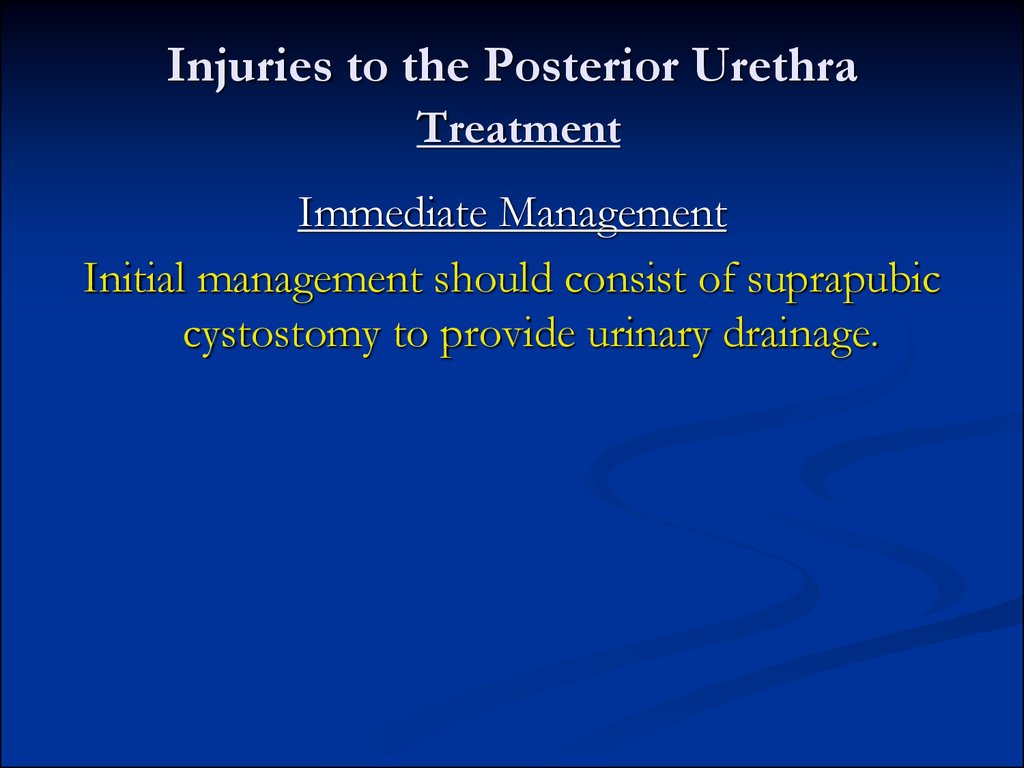

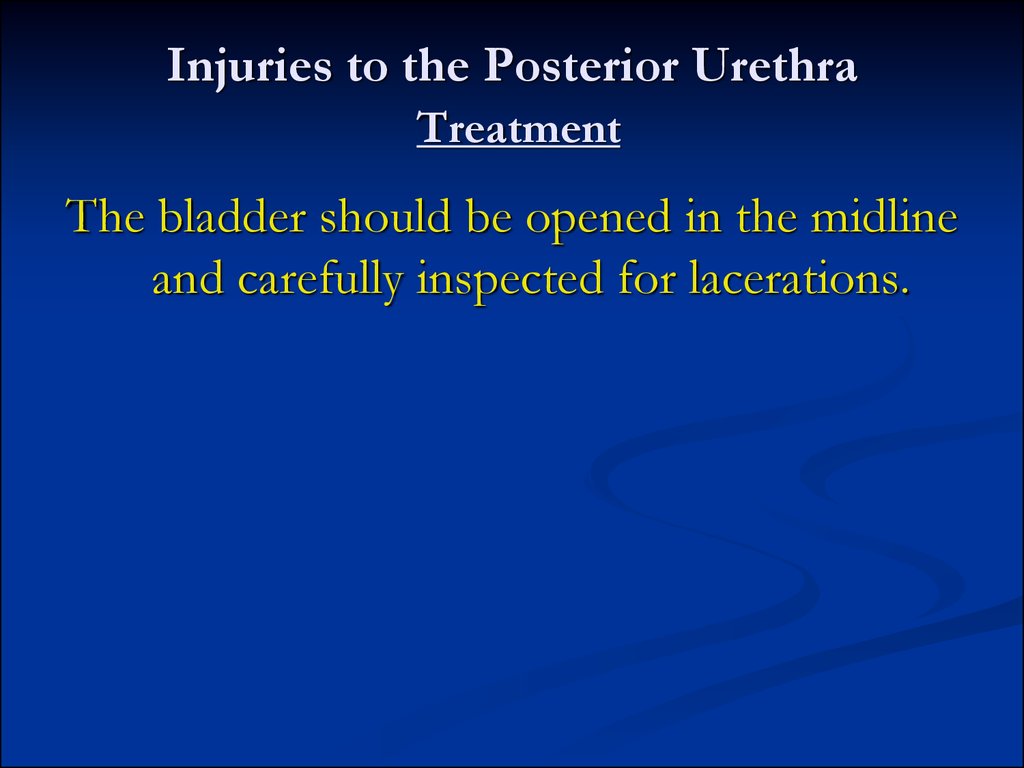
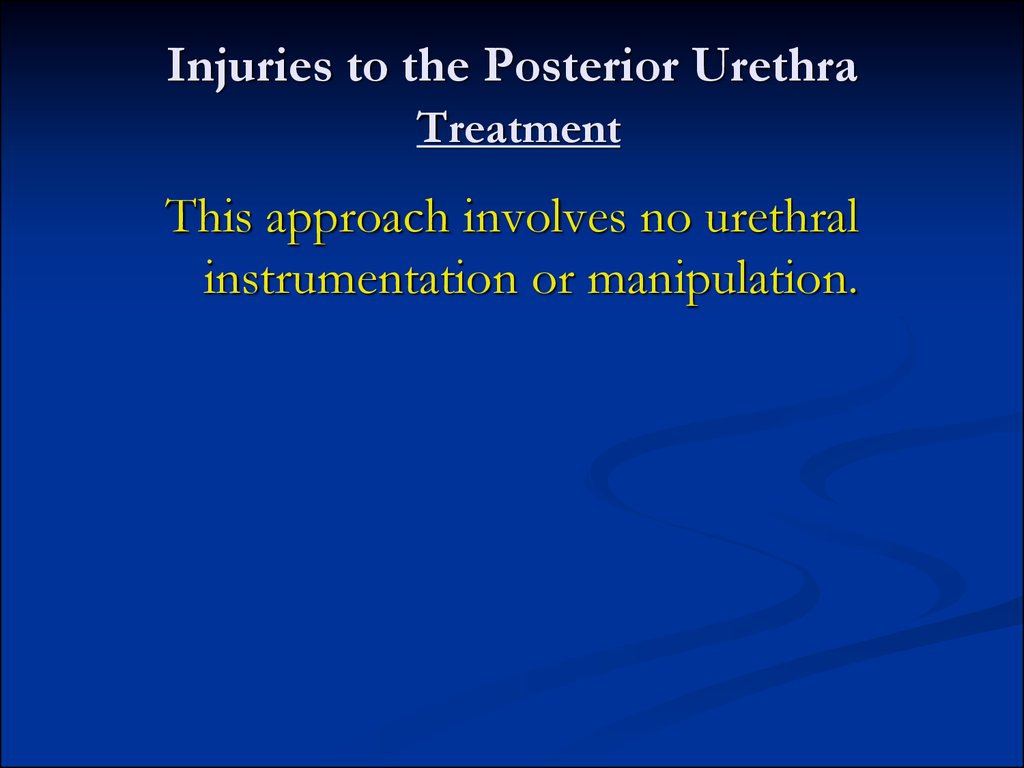

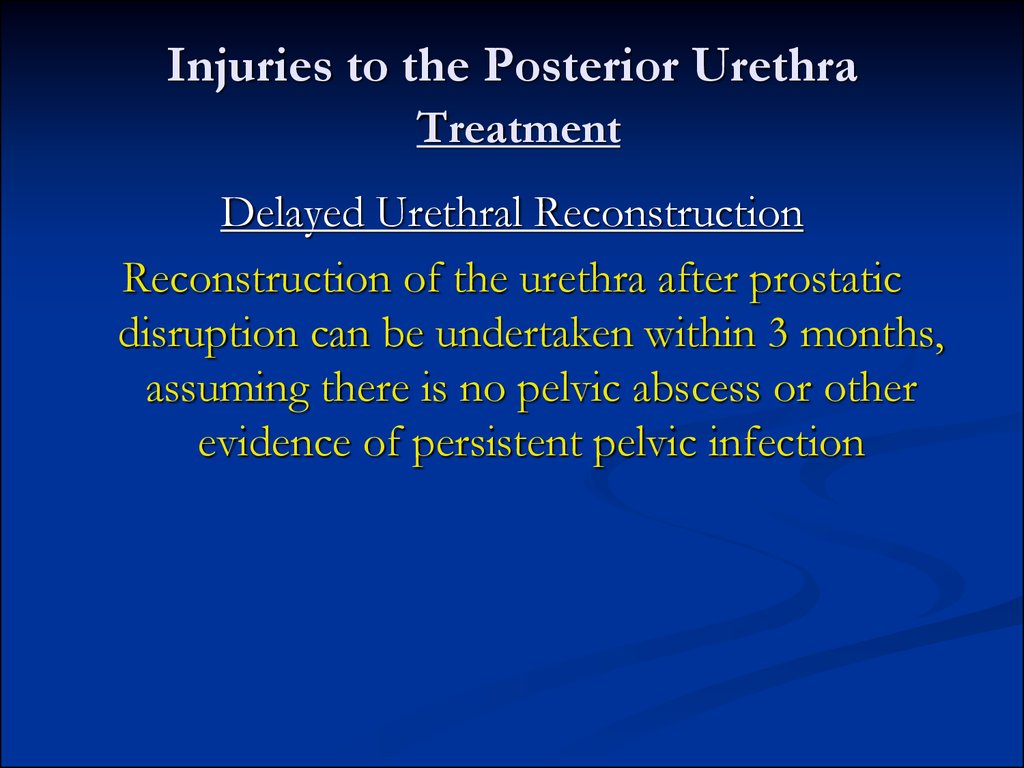
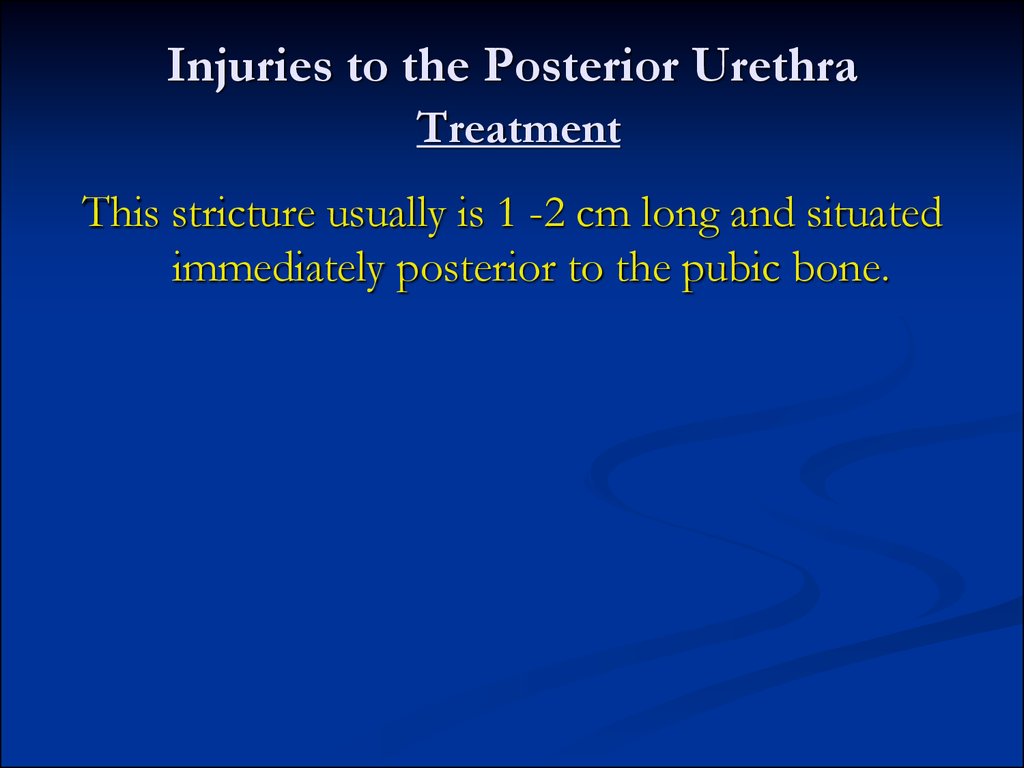
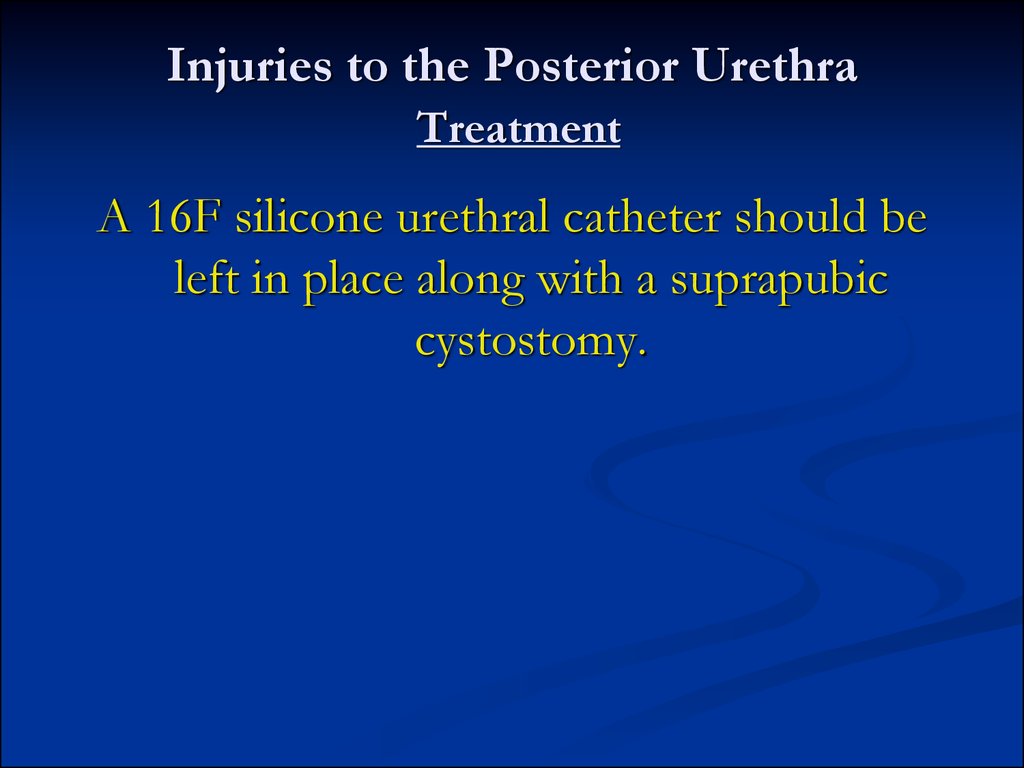

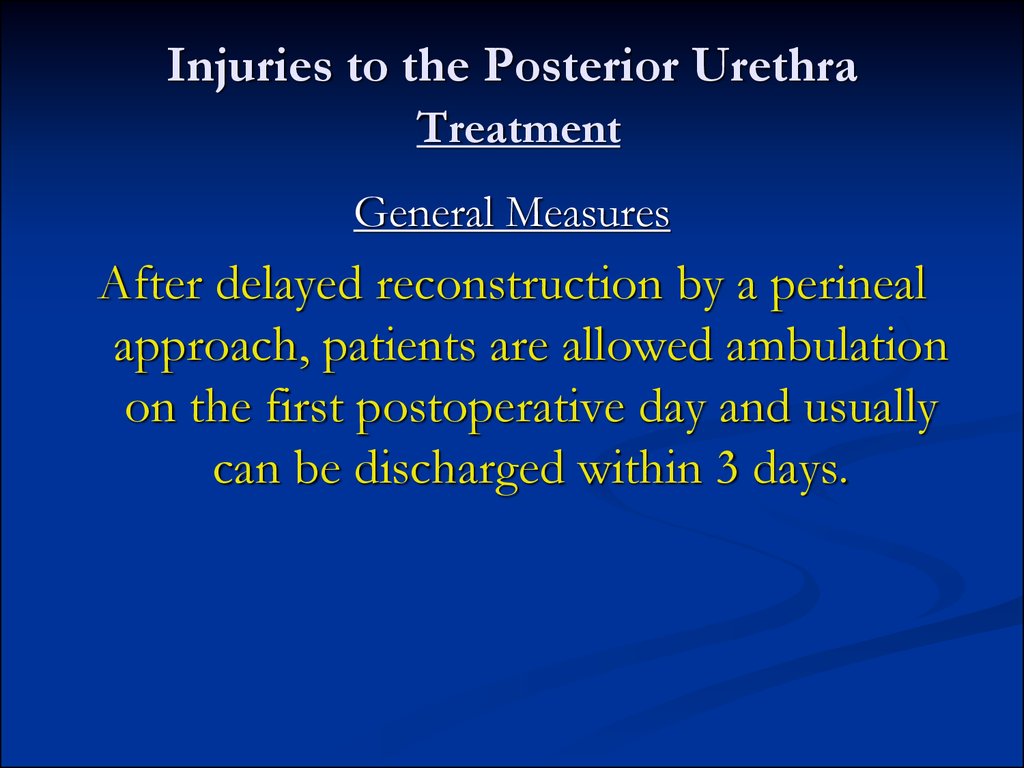
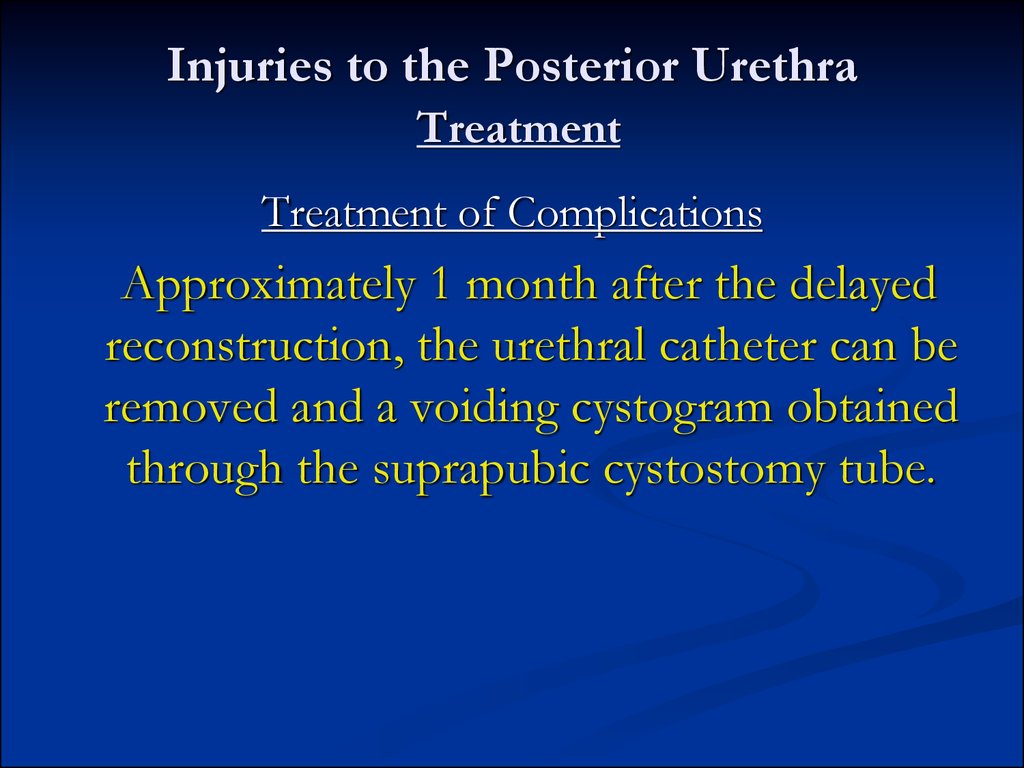
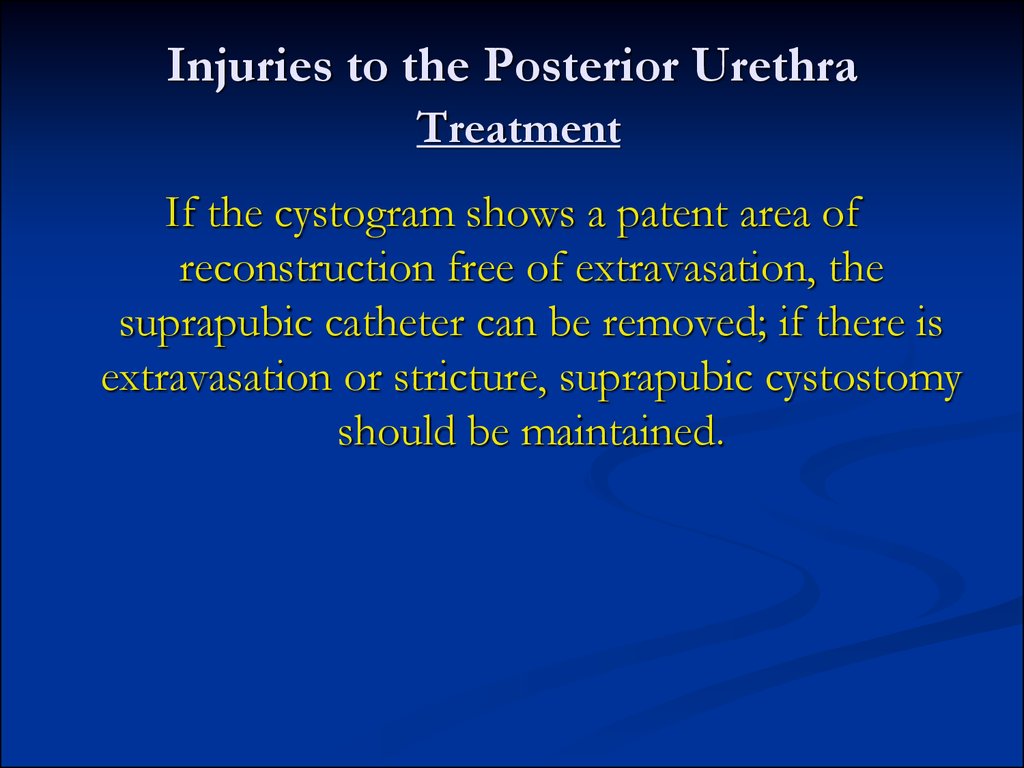

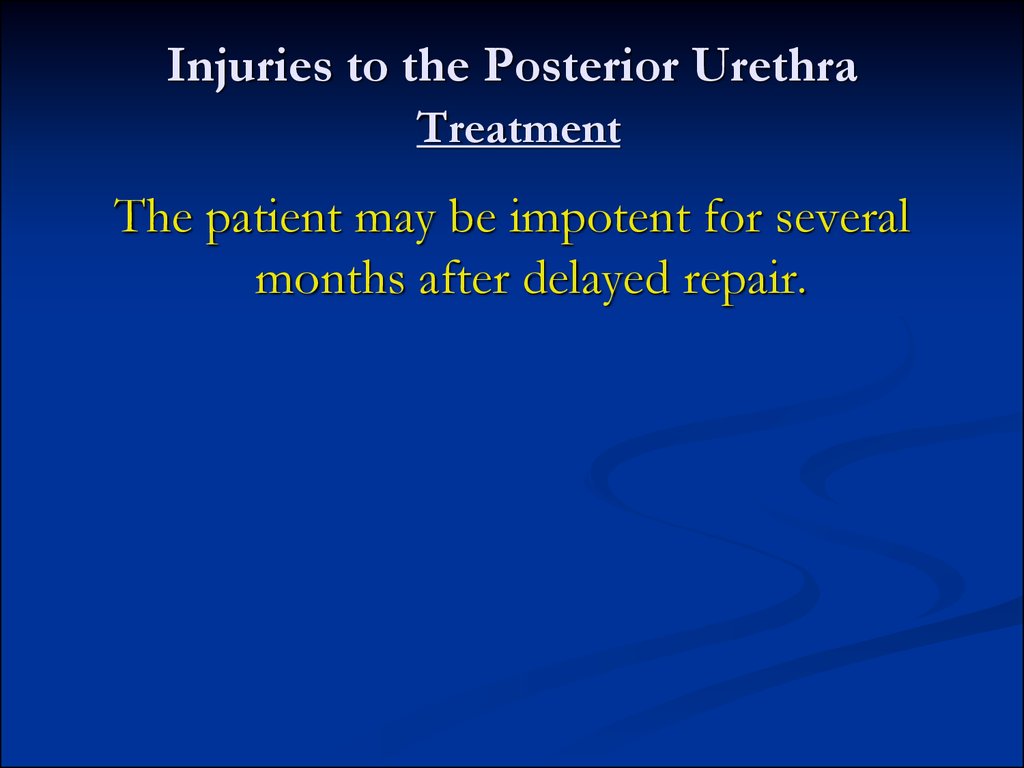

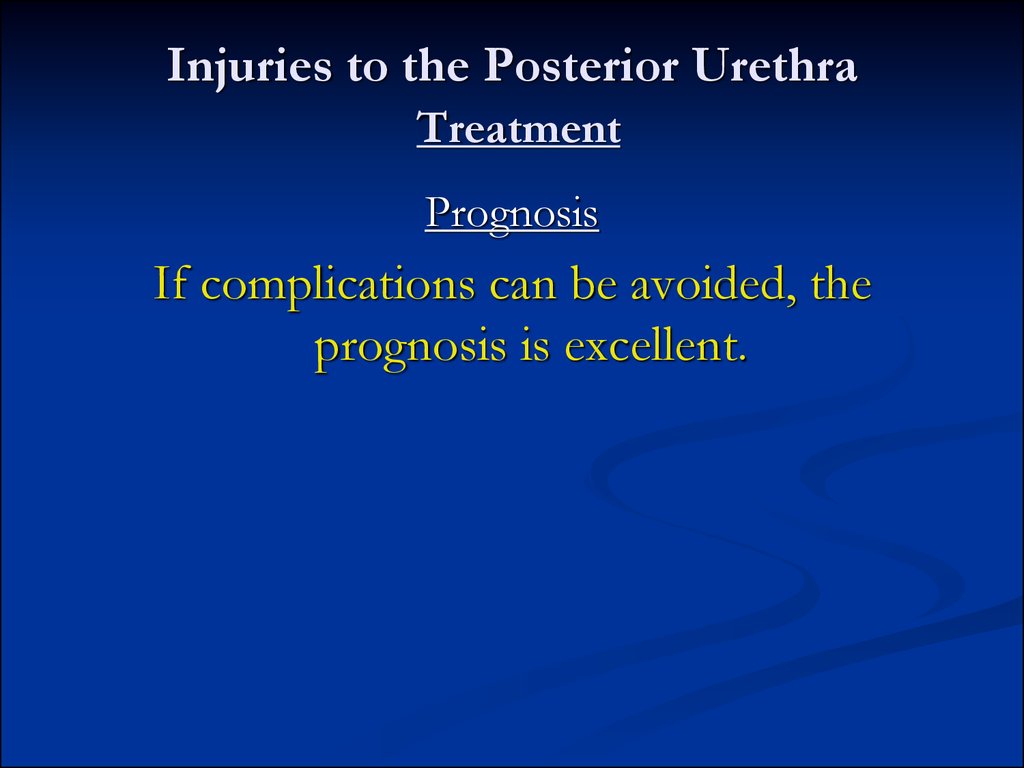
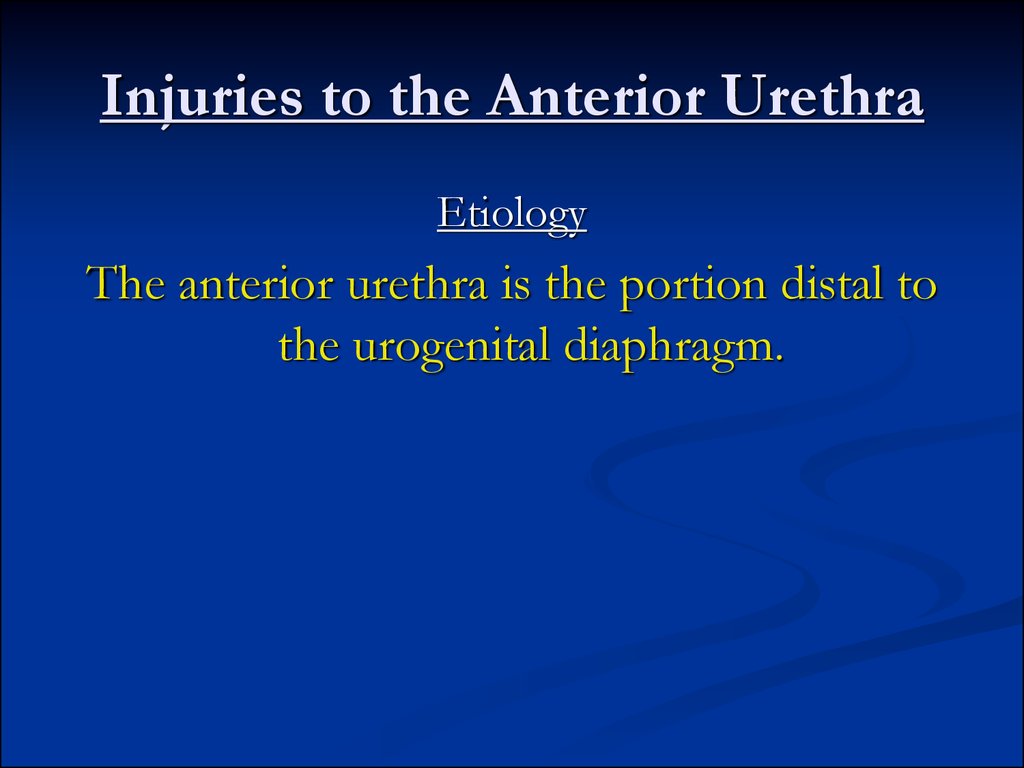
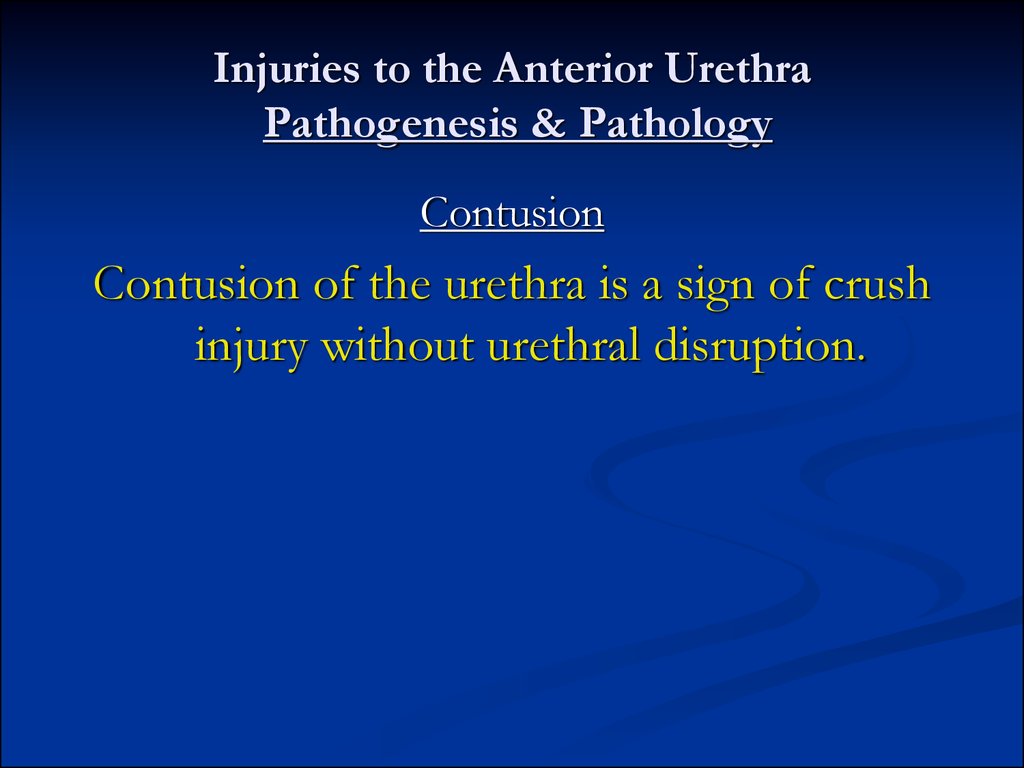
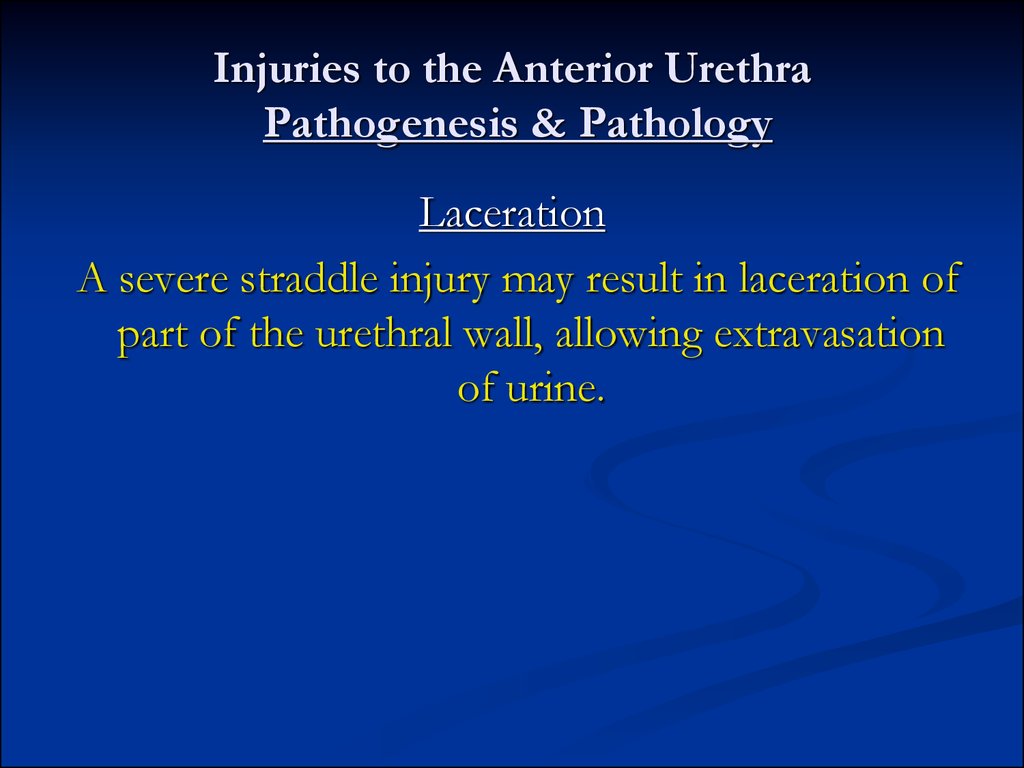
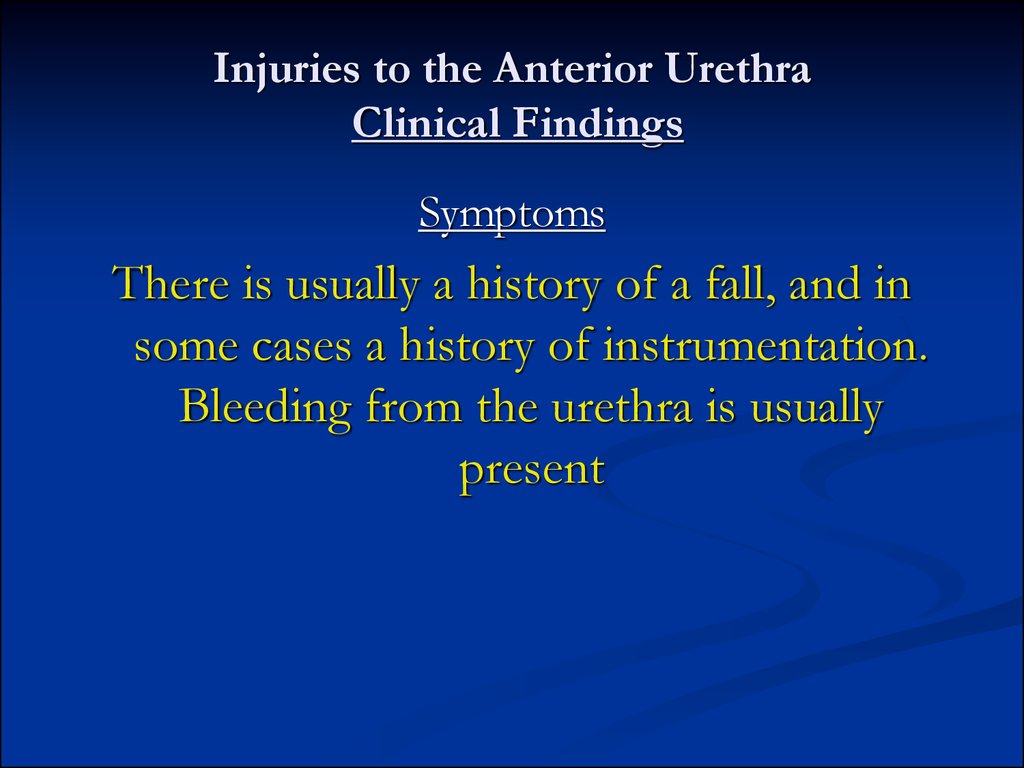
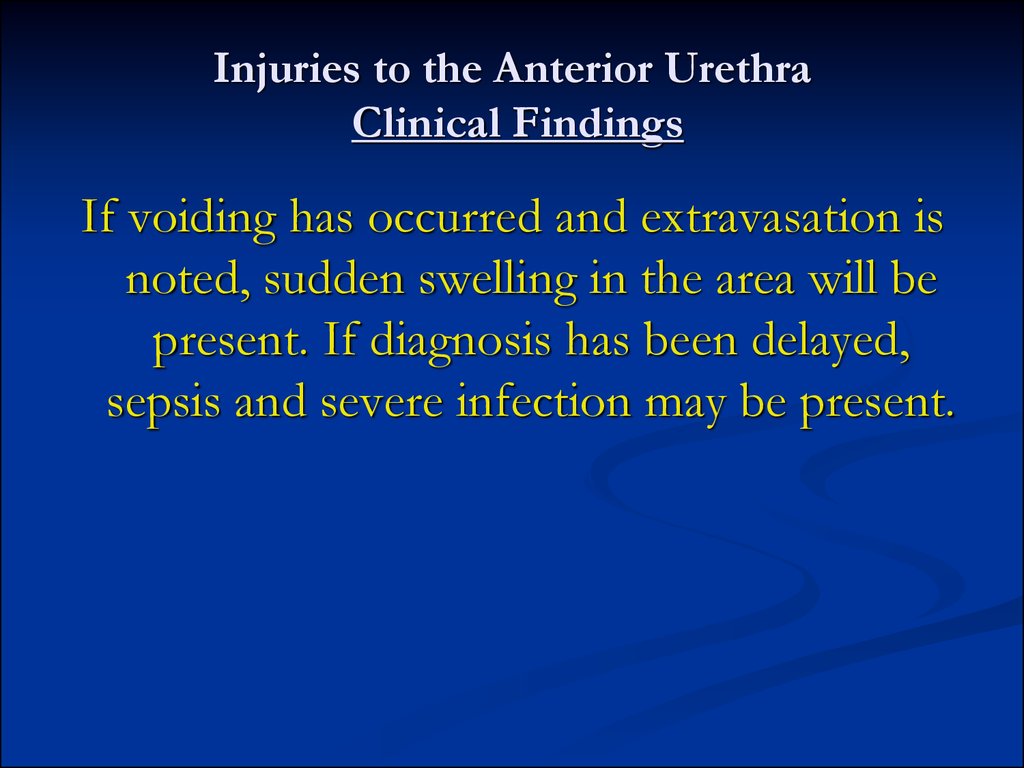
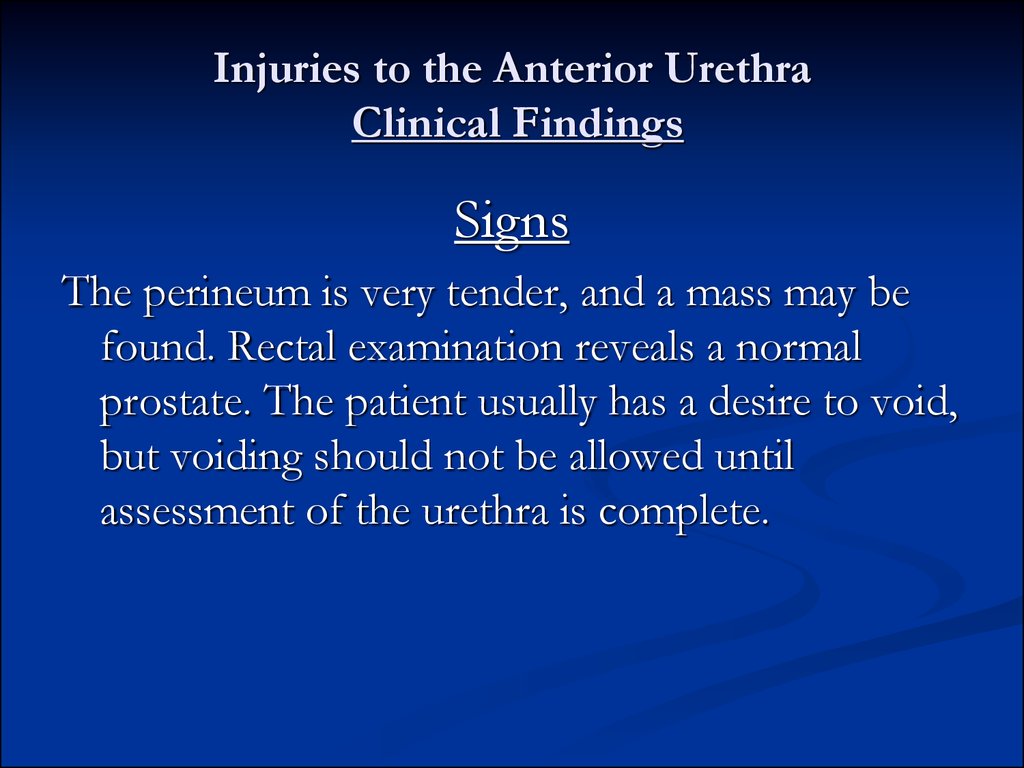
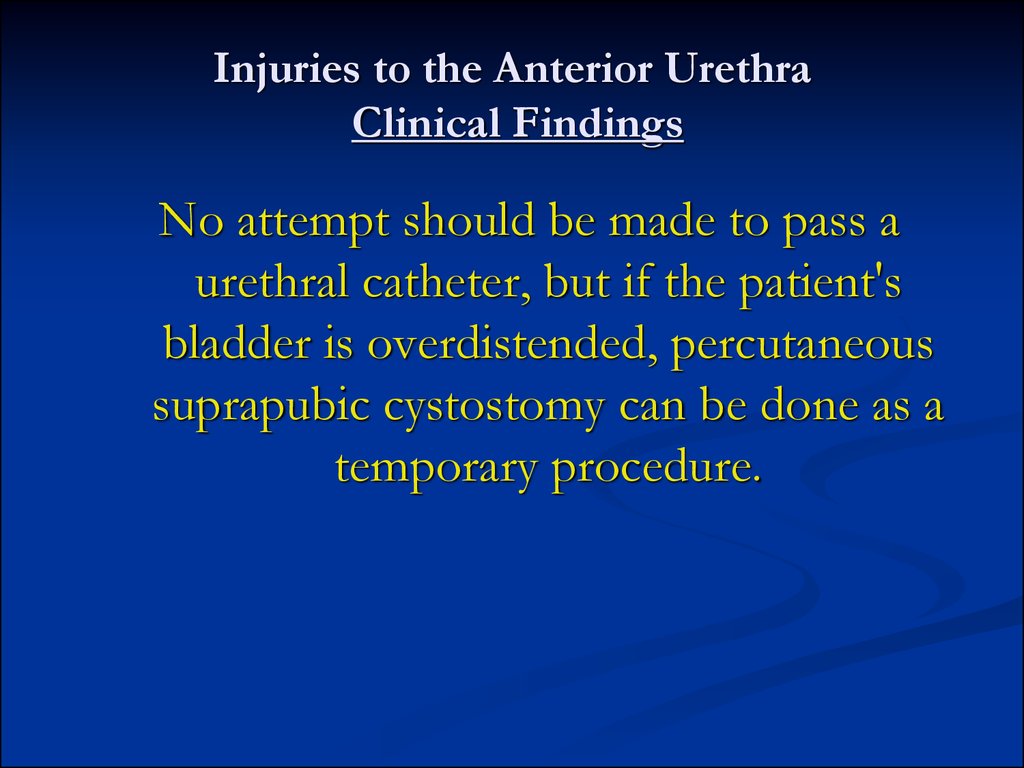
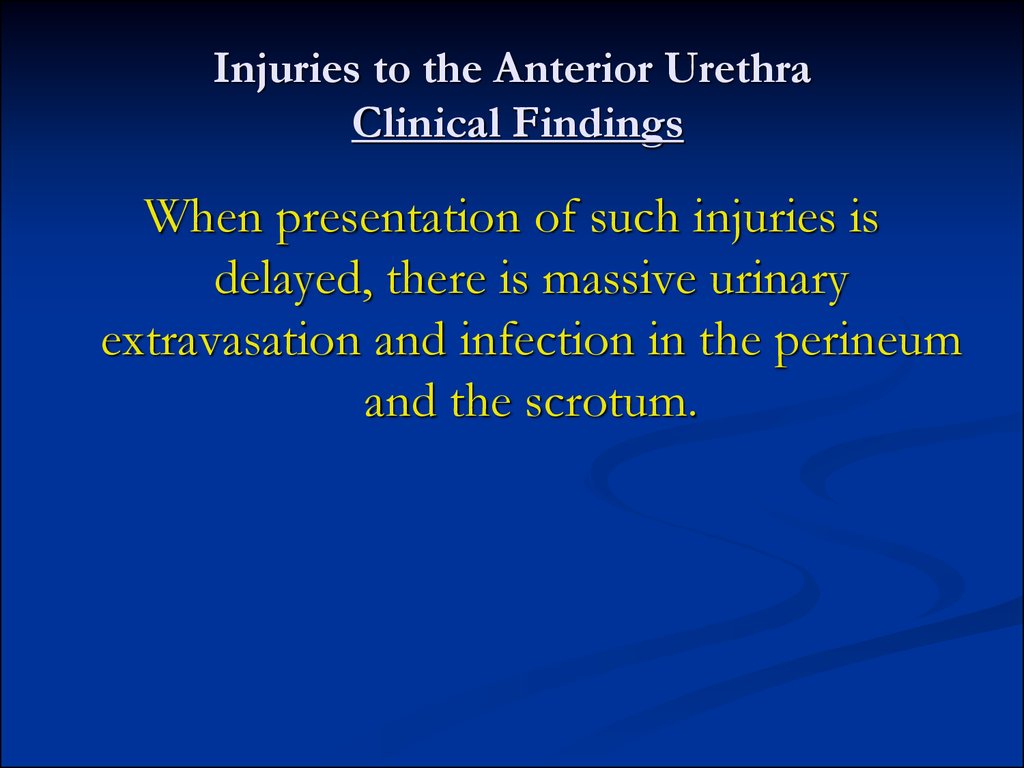
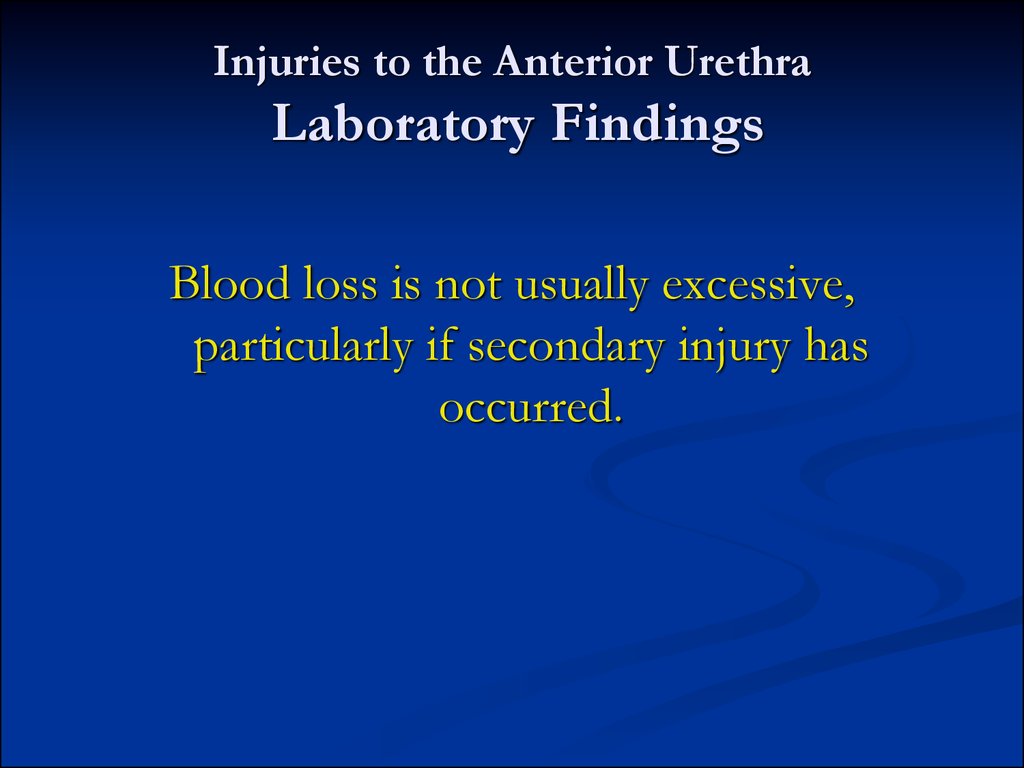
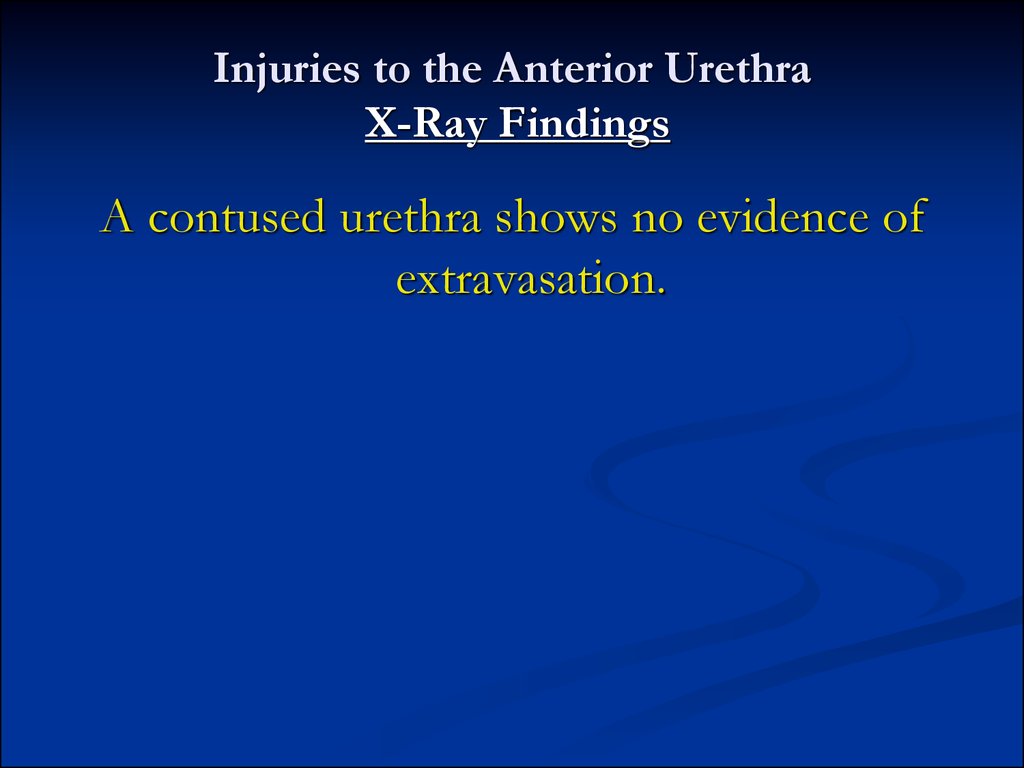
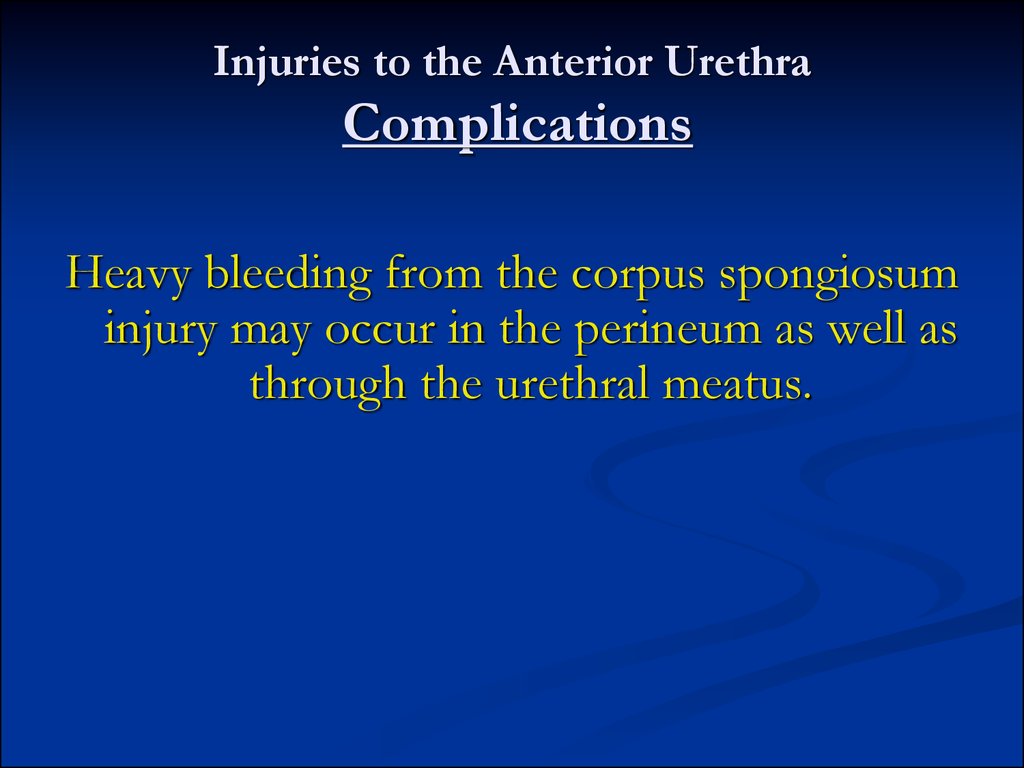
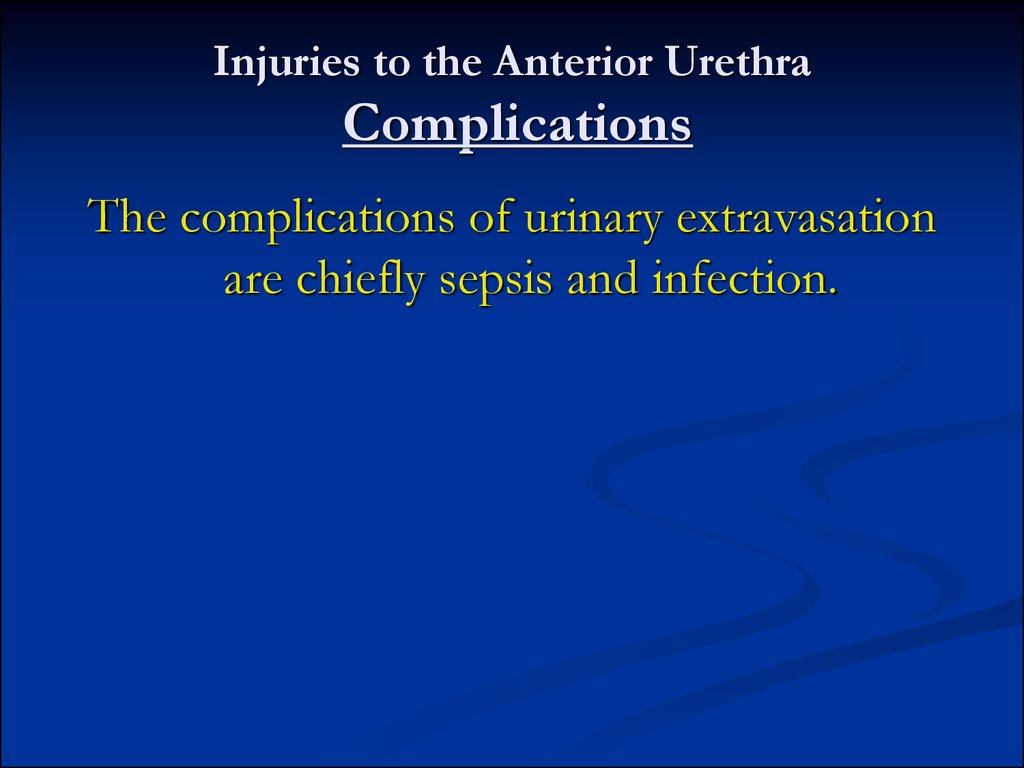
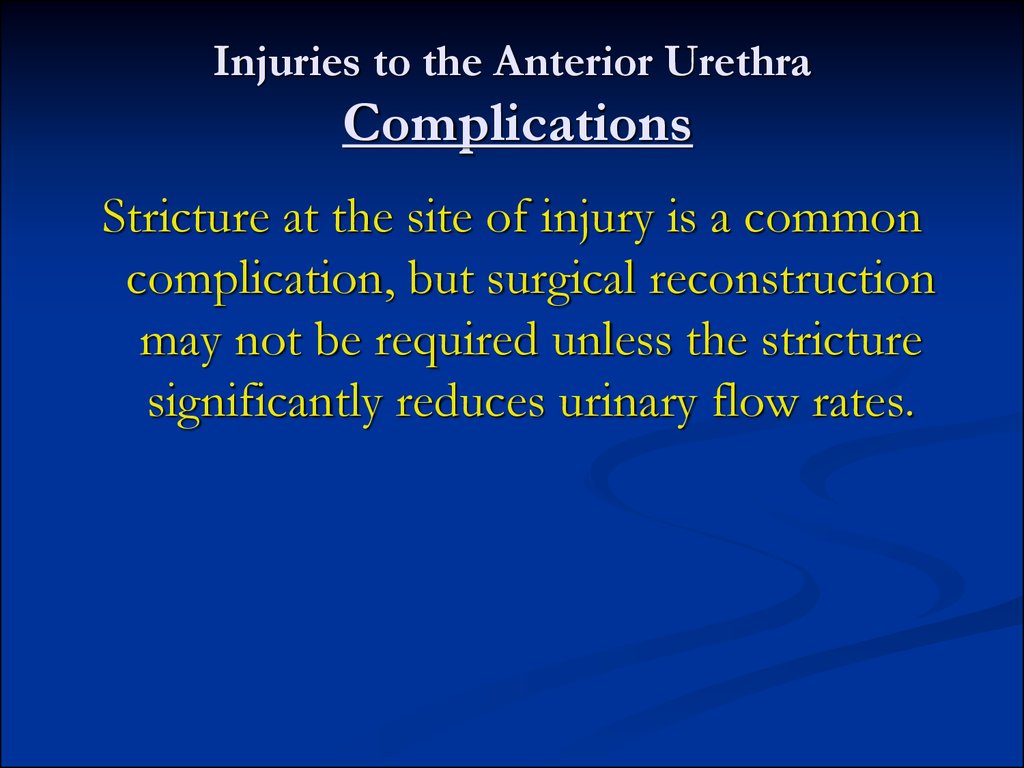
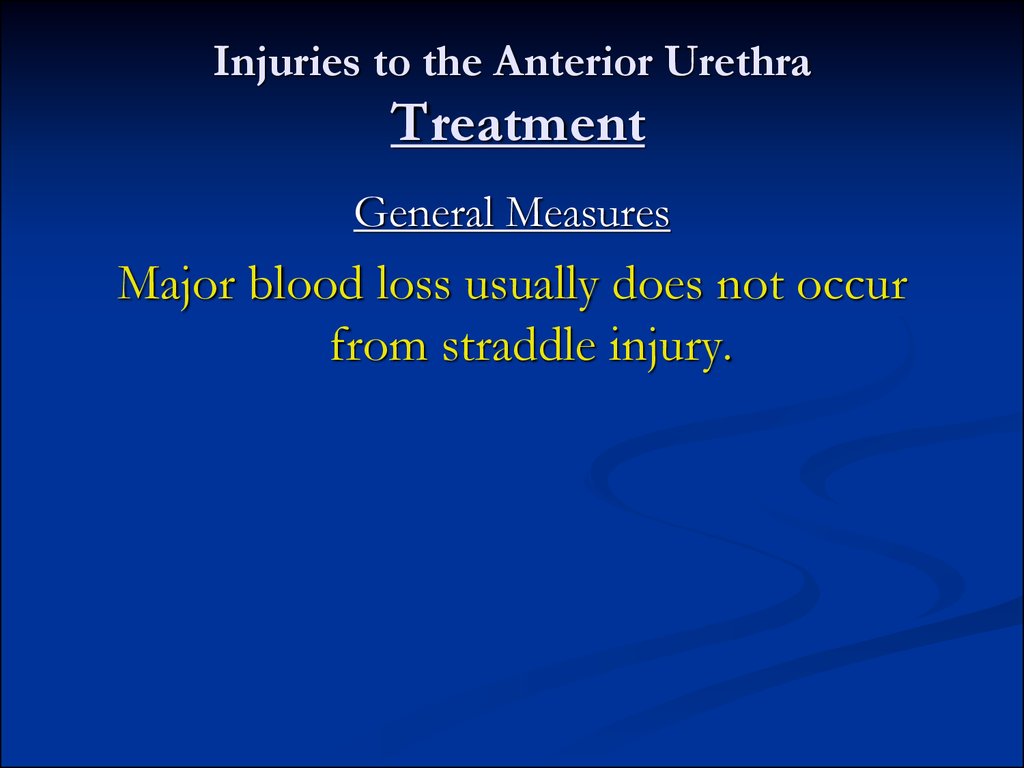
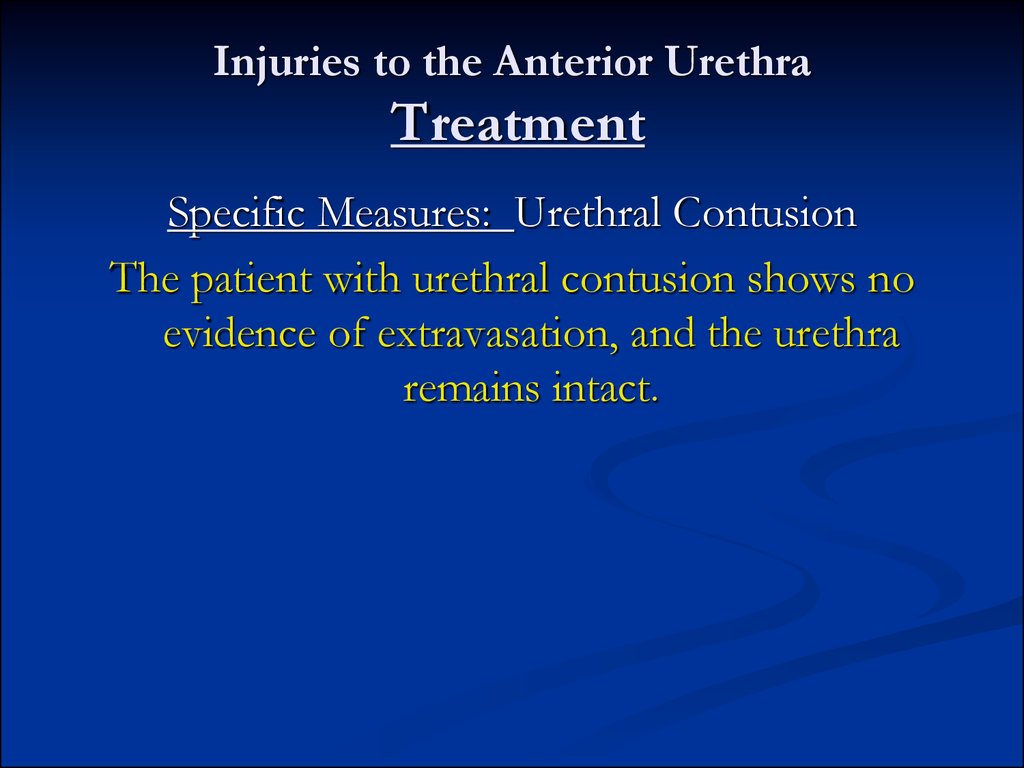
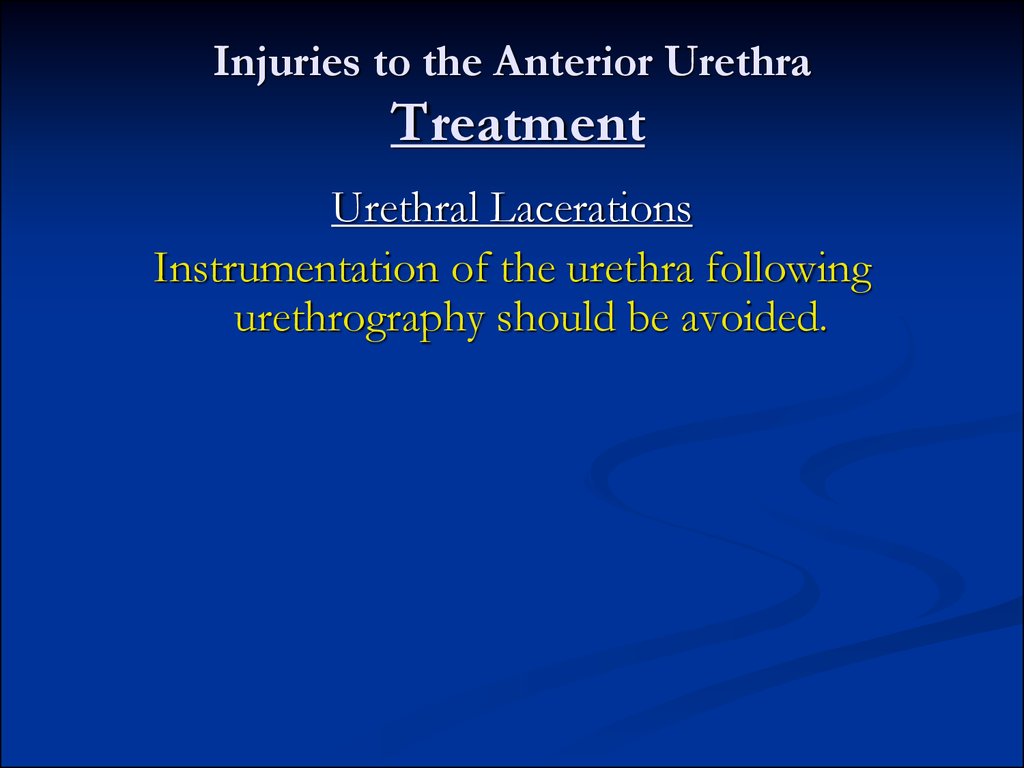
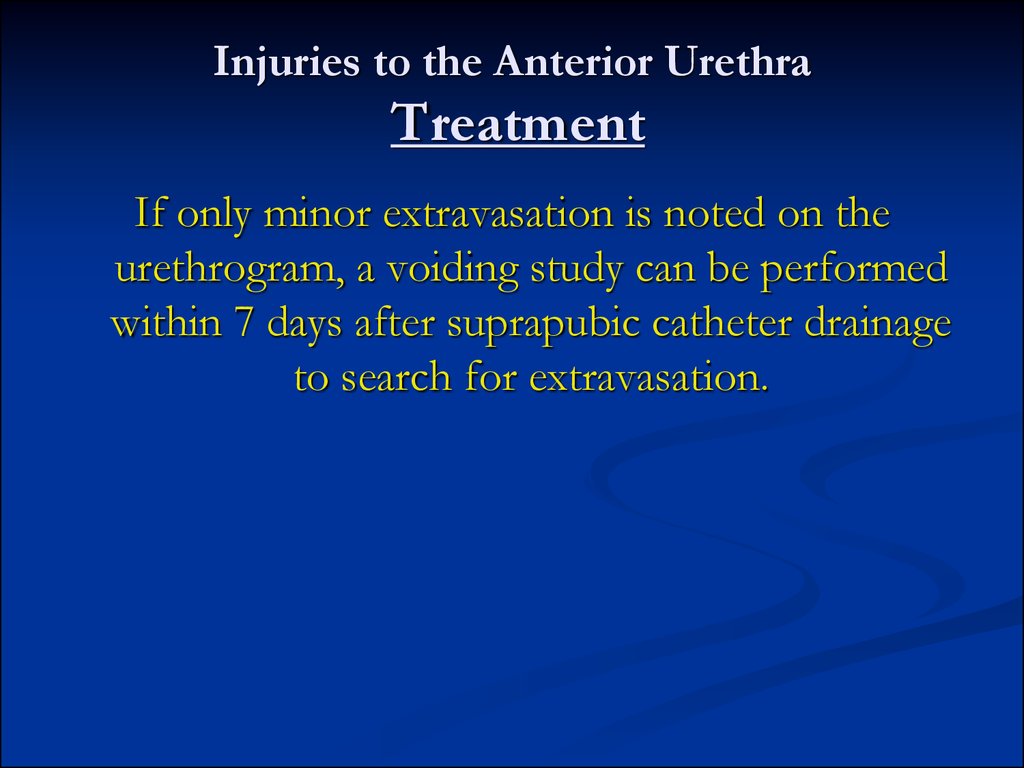
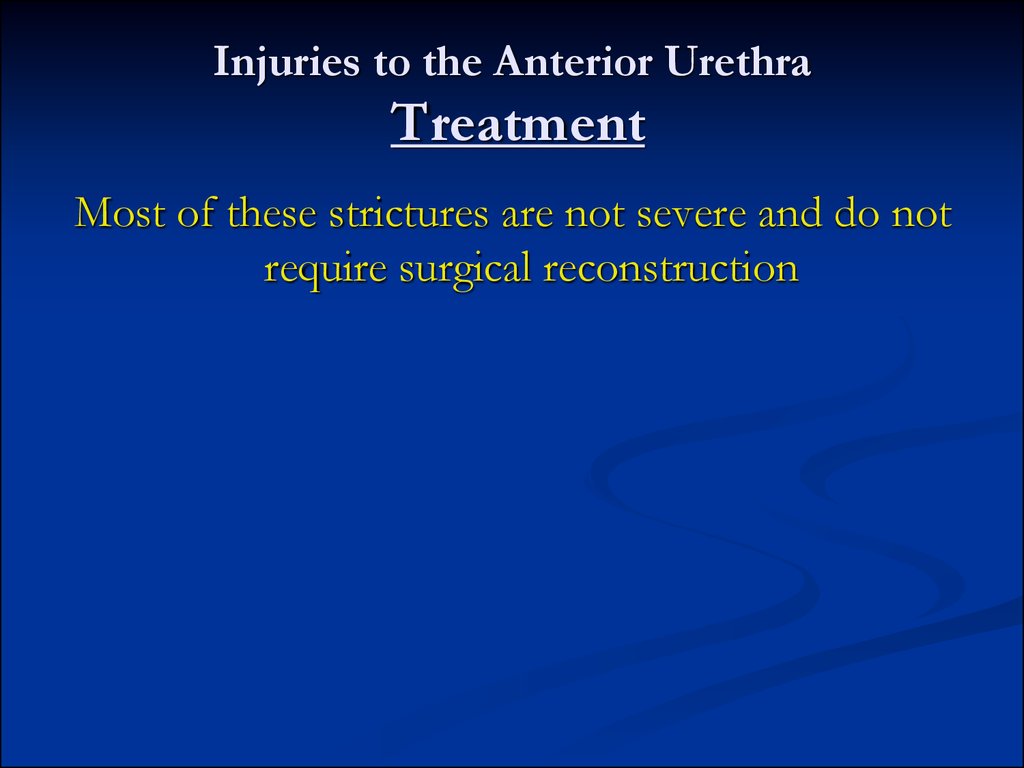
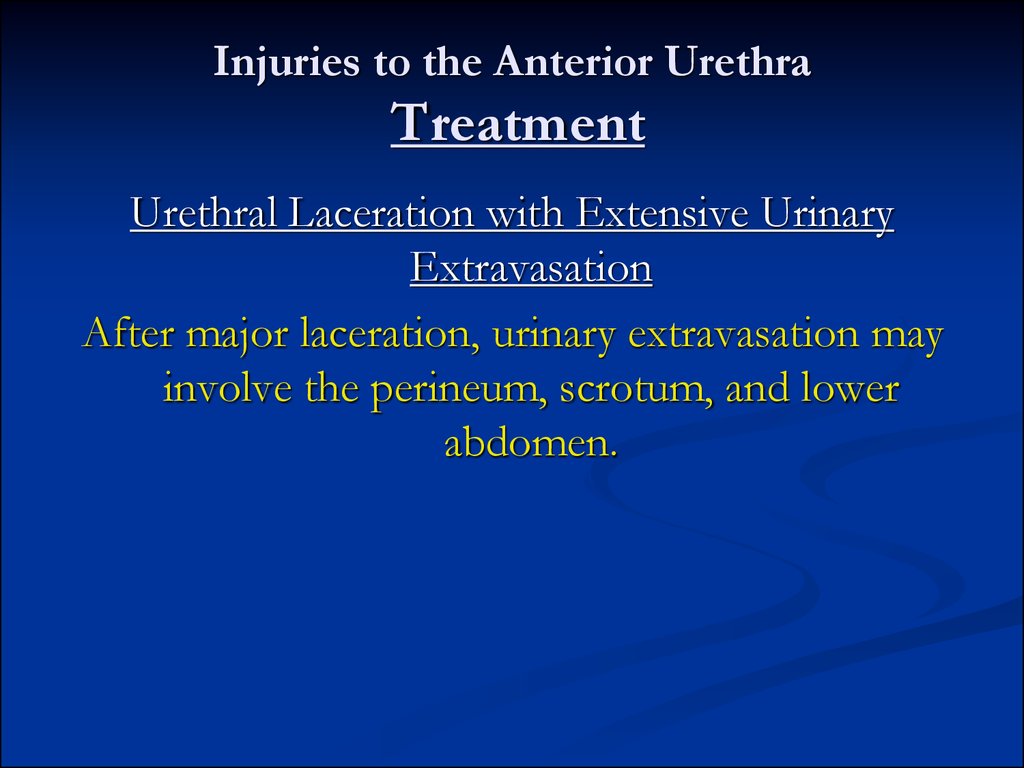
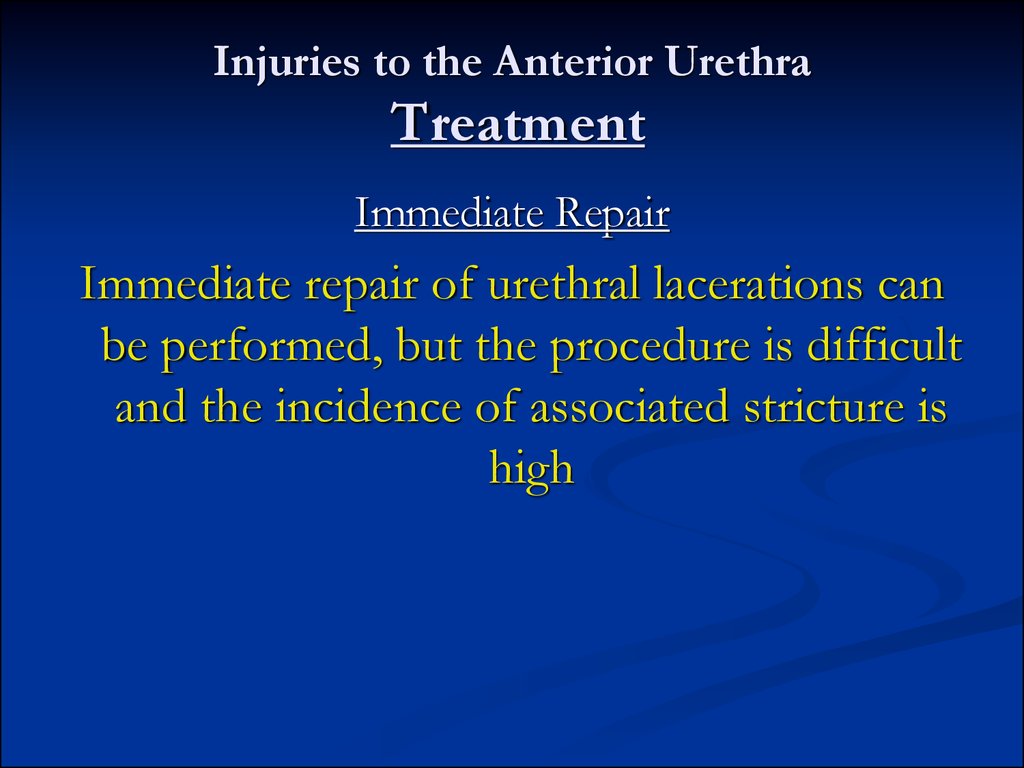
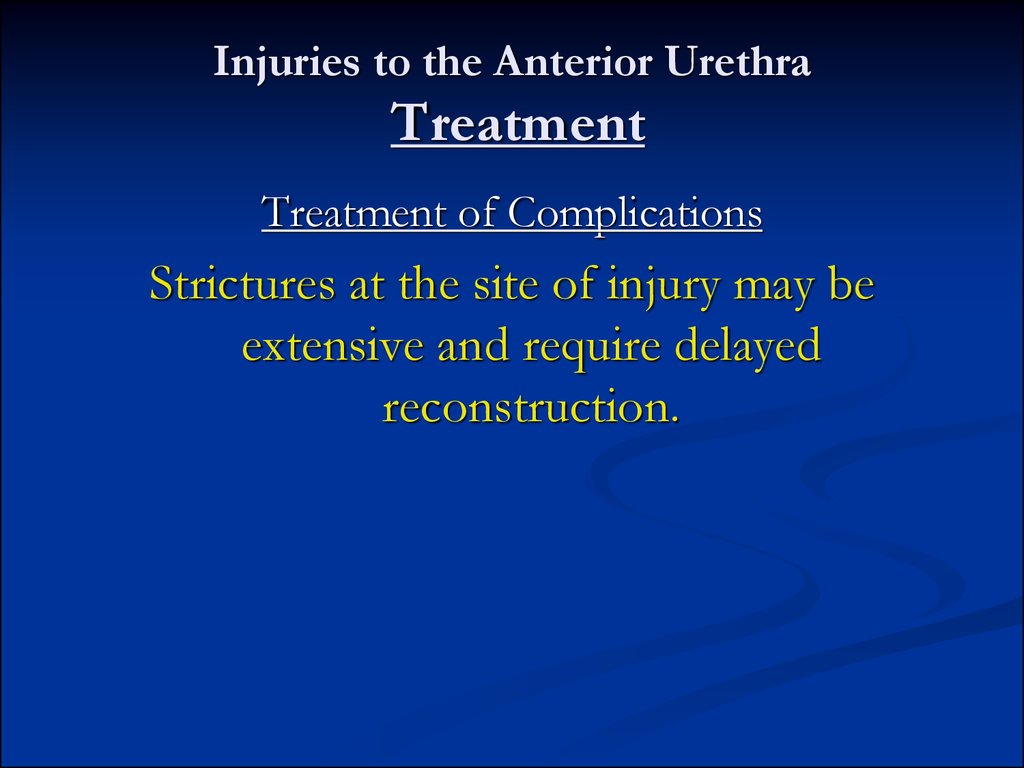
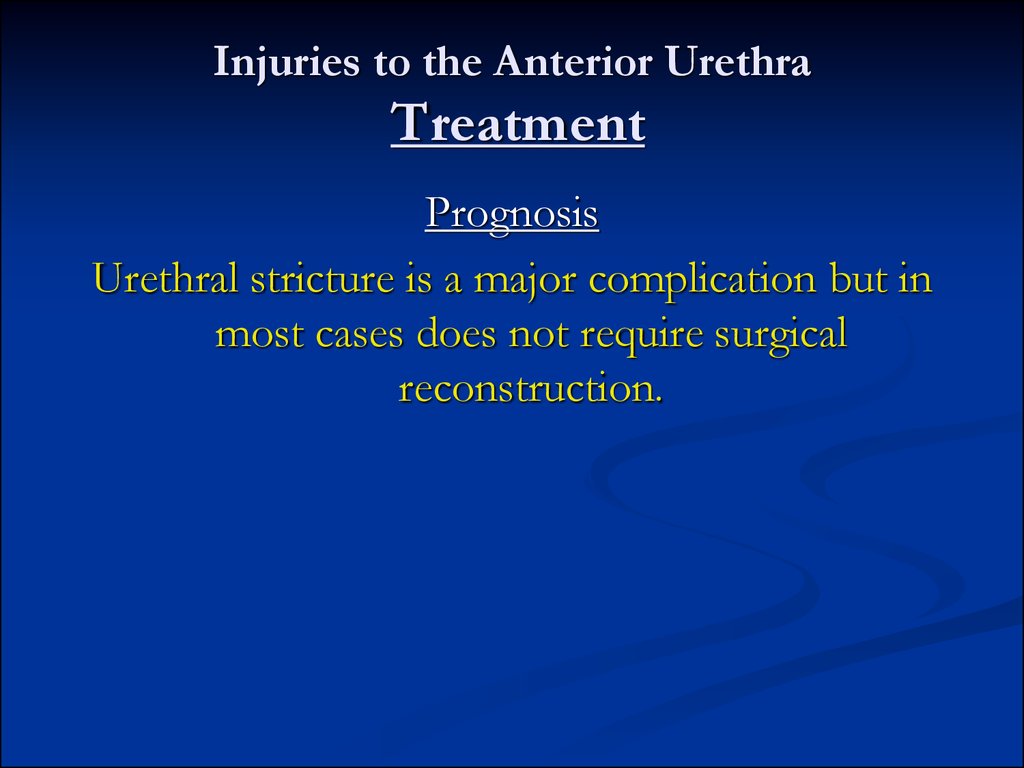
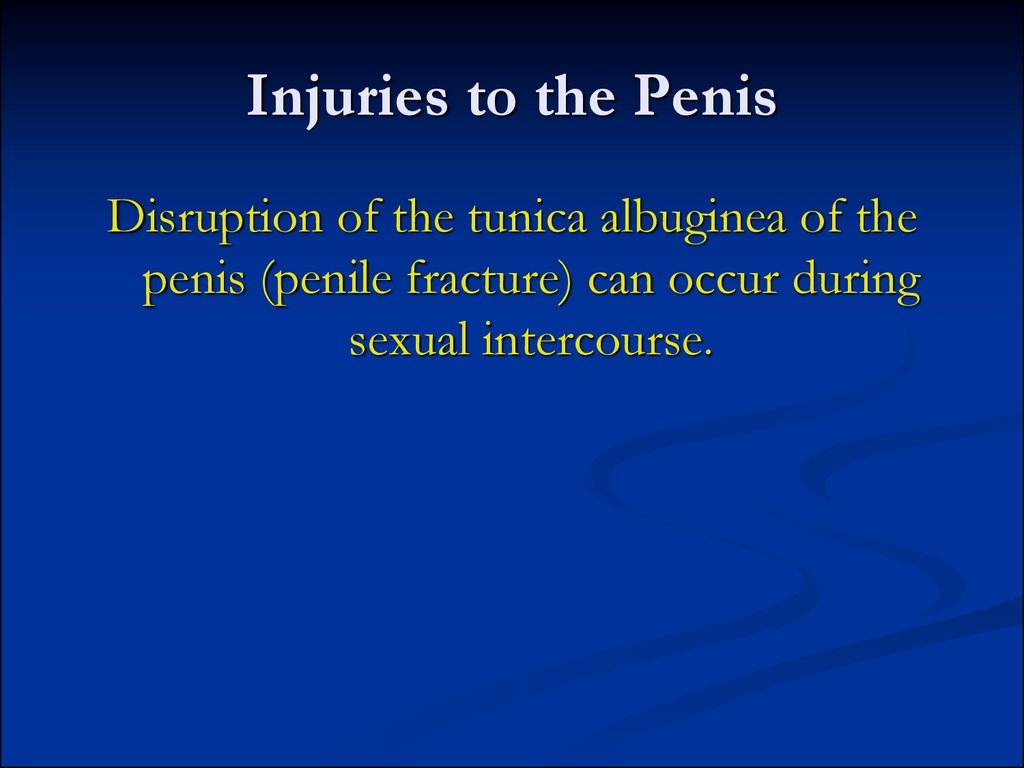
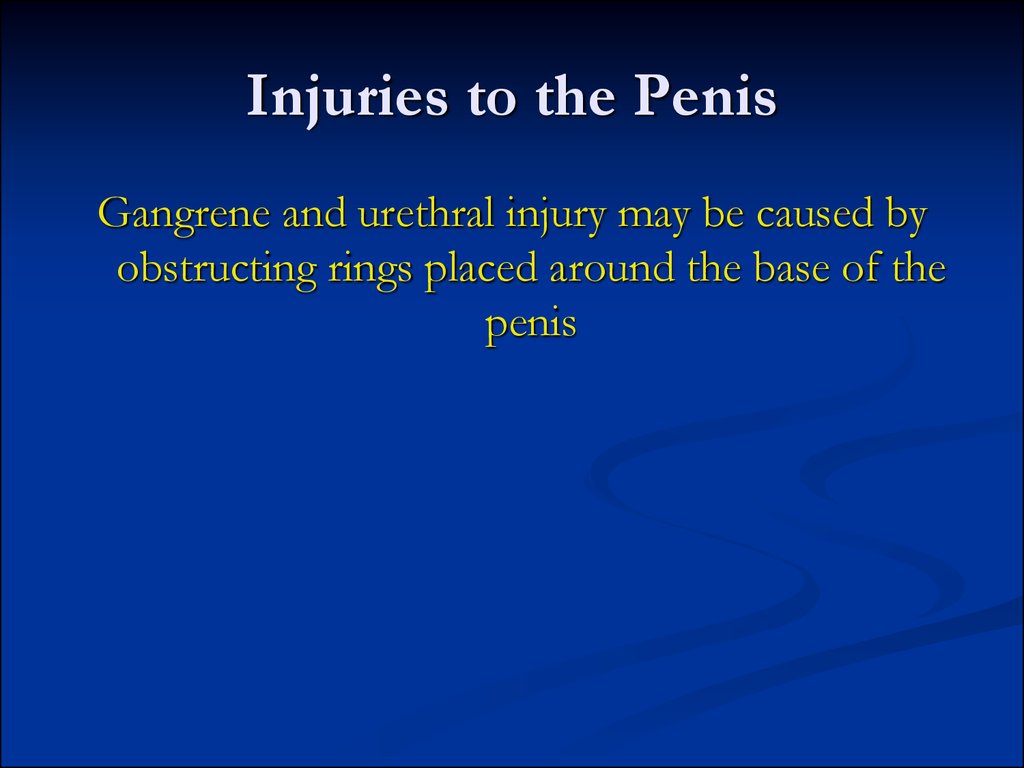

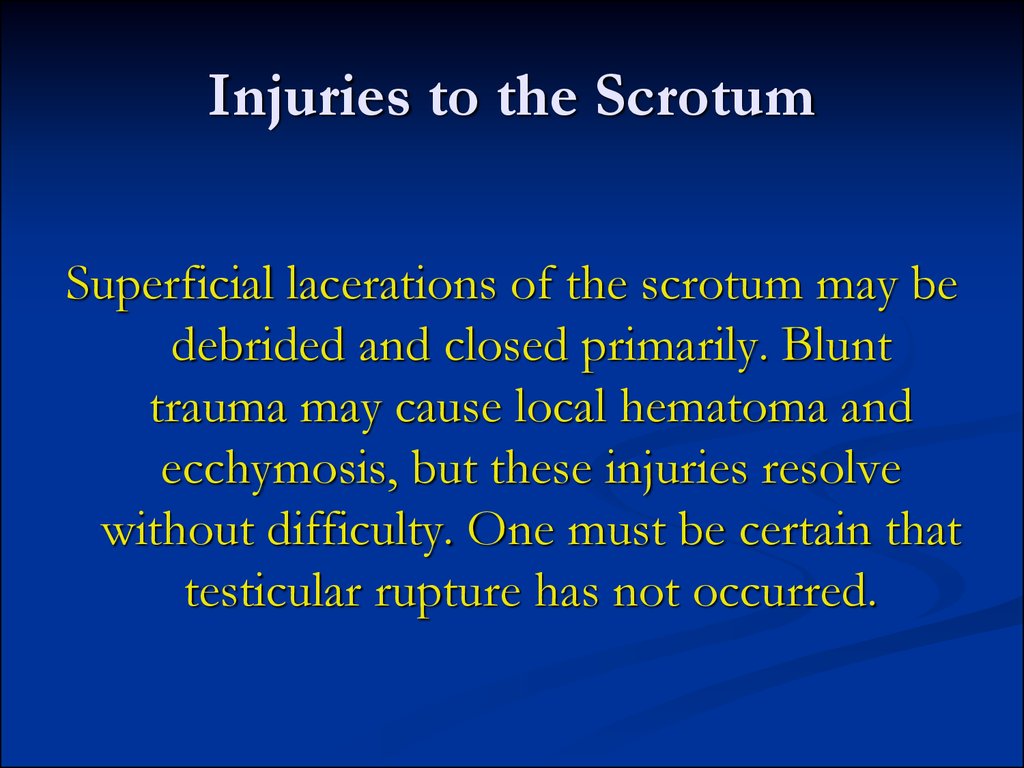
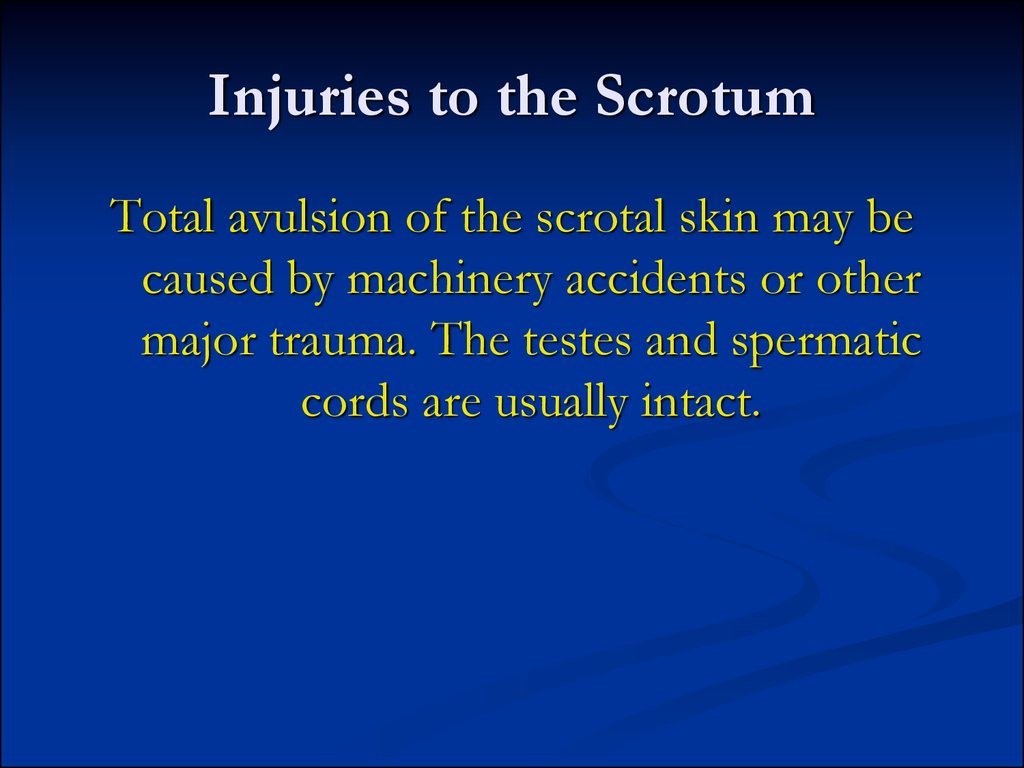
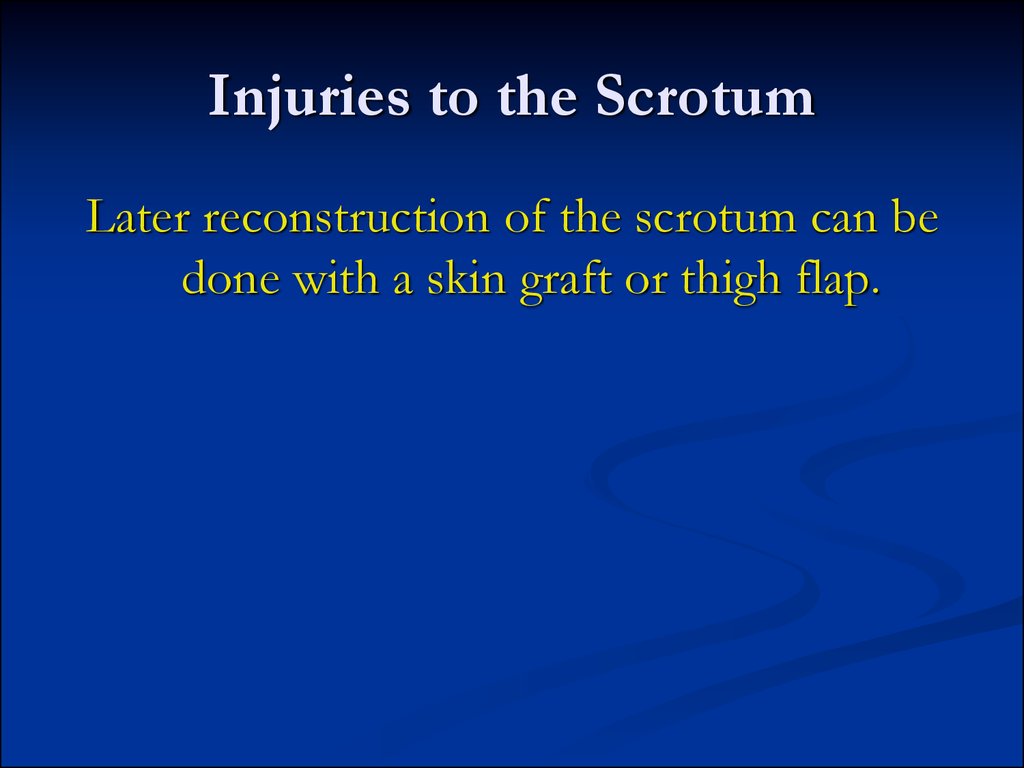

 Медицина
Медицина








